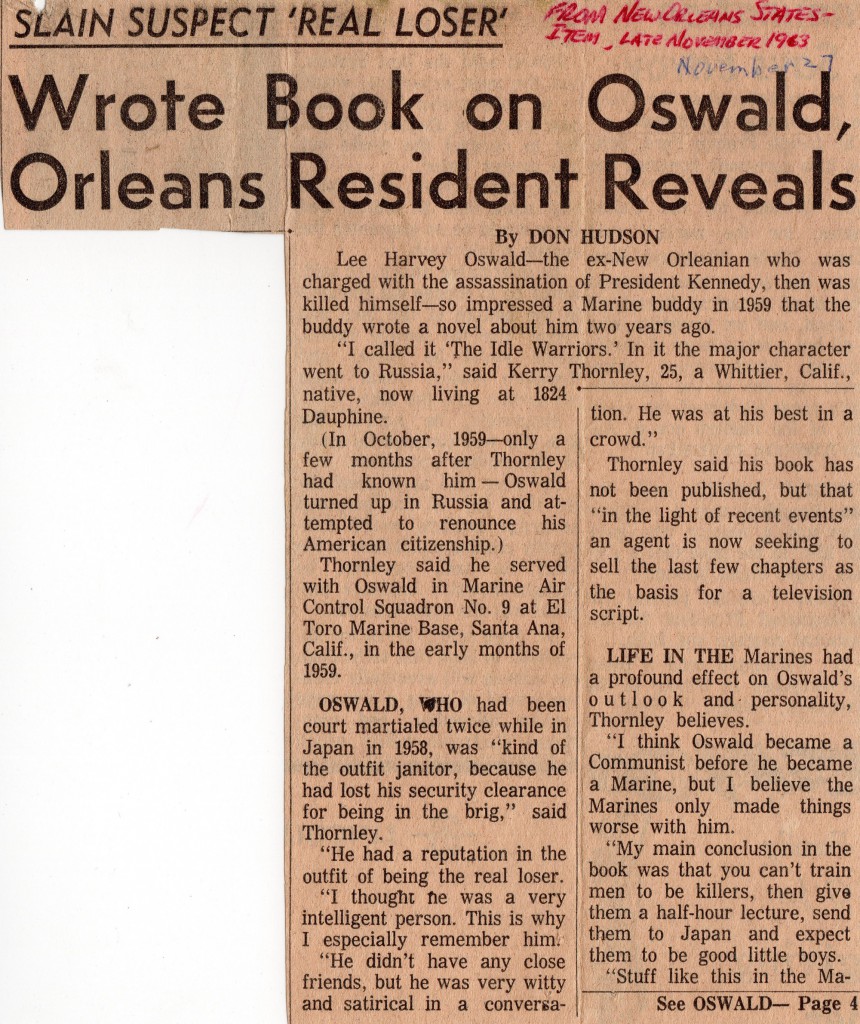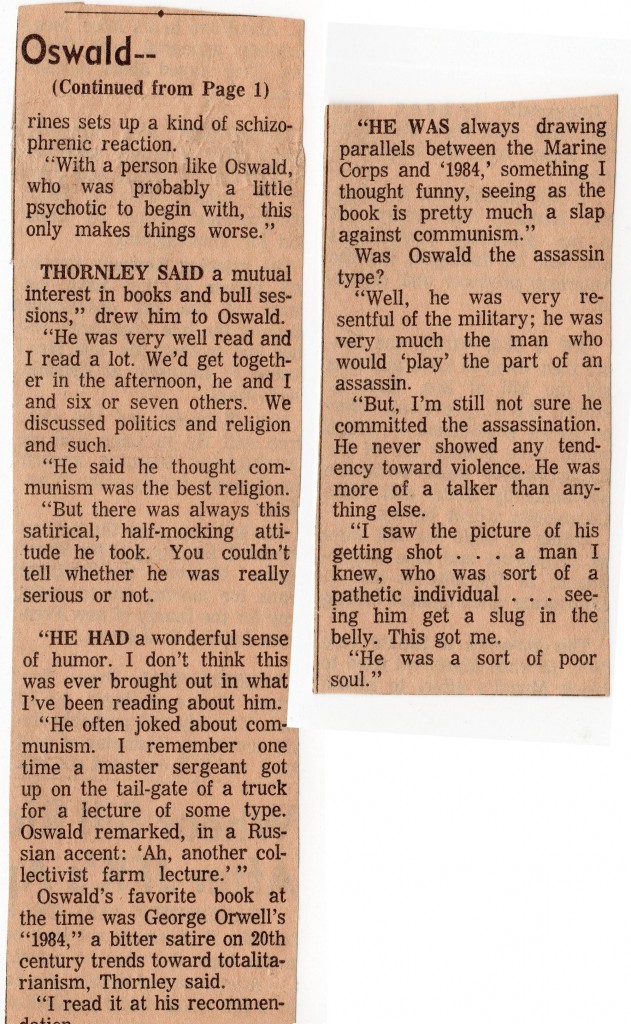This was today in Discordian History. And don’t you forget it.

Michael E. Brown regarding the naming of dwarf planet Eris.

Michael E. Brown and the naming of dwarf planet Eris.
This was today in Discordian History. And don’t you forget it.



Among the many discordant highlights to be found in this document includes the first ever (hand drawn) image of the Sacred Chao, which it now can be announced was the brainchild of our beloved Mr. Thornley!
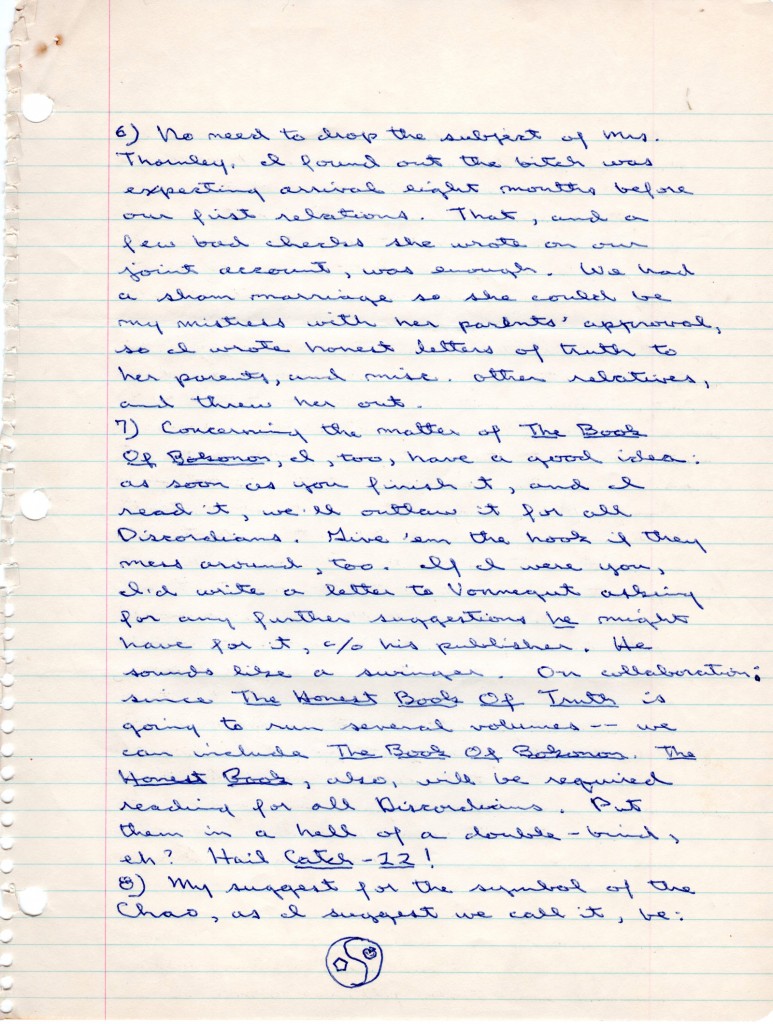
Not long after Thornley cooked up this chaos, Greg Hill gussied the image up and used it for the cover of the first edition of the Principia Discordia: Or How the West was Lost. And the rest, as they say, is Discordian History.
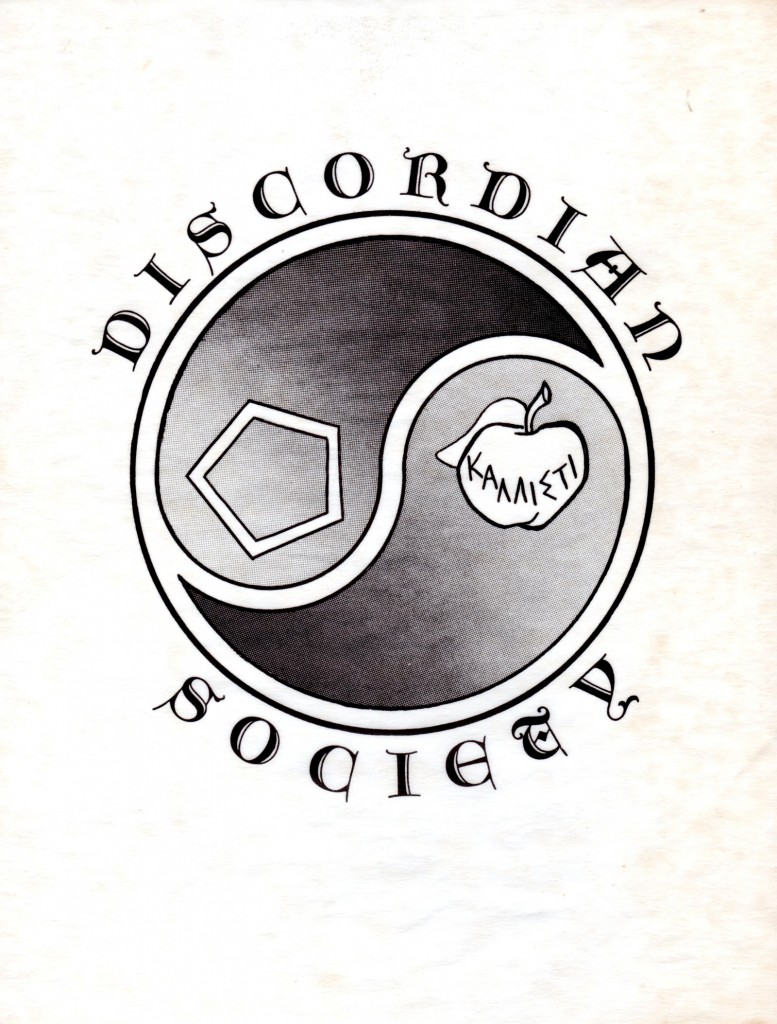
On page 5 (of course) of this chaotic document, we find what I believe was the first ever reference to the Law of Fives, again straight out of Kerry Thornley’s curious brain:
“The Law of Fives is simply a Discordian law that says everything happens in fives. For example: the pentagon always has five sides; the five day work week has five days; there are five pillars of nonsense; five is a number often found in math books. Oh, the list is endless! At appropriate times therefore, for differentiation, we will refer to the Discordian pentagon as the Sign of Five. Rally ‘round the Five, boys!”
A link for this 9-page ancient Discordian document is
available for download here!
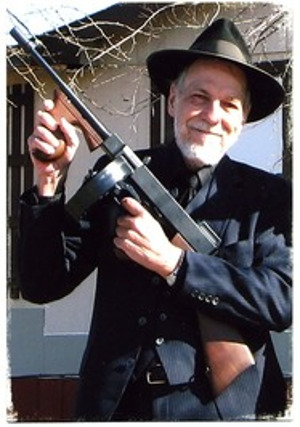
In the meantime, Bill shared this essay with us on the origins of the John Dillinger Died For You Society.
—Adam Gorightly
THE
JOHN DILLINGER DIED FOR YOU
SOCIETY
There I was, at The University of Texas, one evening in the summer of 1966, delivering a brilliantly-researched paper to a small but select American Studies class. They were spellbound by my argument that John Dillinger made a few unorthodox withdrawals from banks and therefore deserved much of the credit for improving their security at a time when Americans desperately needed a “People’s Bandit” to distract them from their Depression worries. (The fact that I also brought to class a modified tenor sax case containing a slightly-illegal Thompson submachine gun, for “show and tell,” fascinated everybody.) (You could get away with such things back then.)
As I pointed out, Dillinger had just the right style–a sense of humor, occasional pranks, treated his hostages like guests (he tied the Racine bank’s Mrs. Patzke to a tree with a shoe string), eluded every police and FBI trap, and when he broke out of the Crown Point, Indiana jail with a wooden pistol, he took a couple of happy hostages and motored out of town singing “Git along, li’l doggie, git along.”
He also was a ladies’ man—playful and romantic—until that terrible night on July 22, 1934, after he, his new girlfriend, and the duplicitous “Woman Red,” had enjoyed “Manhattan Melodrama” at Chicago’s Biograph Theatre. As they were leaving, a bunch of trigger-happy Feds set his spirit free.
(The fact that they also winged two bystanders is rarely mentioned.)
John died with his boots on, so to speak. He previously had stayed up nights nursing his girlfriend (who was ignorant of the plot) after she was banged up in a car wreck. My very own Aunt Meta was a student nurse at Cook County Hospital at the time, and she wrangled her way into the basement Cool Room to see his remains. The next day, despite the city’s hundred-plus heat wave, nearly a thousand Chicagoans patiently waited in line outside the morgue, where they were allowed to file past John’s bullet-ravaged body. Some no doubt wept. And what with the usual odors, the stench of formaldehyde, and the flies attracted to his terrible wounds, this may well have been the inspiration for what now is called “A Taste of Chicago.”
Back in 1966, however, when that particular college class had adjourned to the back-yard area of Austin’s historic Scholz Garten, our Pulitzer Prize-winning professor, Dr. William Goetzmann, after quite a few beers, proposed that we establish The John Dillinger Died For You Society. It was intended to be no more than a spoof of the Elvis Presley fan clubs that were springing up everywhere (and of the “Jesus Died For You” signs that were coming into flower), so you can imagine the enthusiasm that my Dillinger paper inspired among the other students, who also were chuckling over the Presley fan clubs and weary of hearing how anybody “died for you.”
By then Dr. Goetzmann was tipsy enough to further declare that the Society’s founder should be Horace Naismith, a mythical figure who would delegate his authority to me. That name, Horace Naismith, came out of nowhere, but it could easily be mistaken for the fellow who invented basketball. (I don’t believe anybody thought of that at the time, but it later would come in handy: “Naismith? Wasn’t he the guy who…”)
We soon had a few dozen more-or-less official members of the Society and had membership and credit cards printed, but it was not what you’d call a formal organization, like the American Legion or Rotary Club. Everyone in the Society was automatically an Assistant Treasurer authorized to sell memberships to anyone at any time for any amount and then keep it, Because John would have wanted it that way.
The “credit card” had a hole at the top and read simply, “Present this card on the end of a pistol and ask that your purchase be charged. In most states the charge will be armed robbery.”
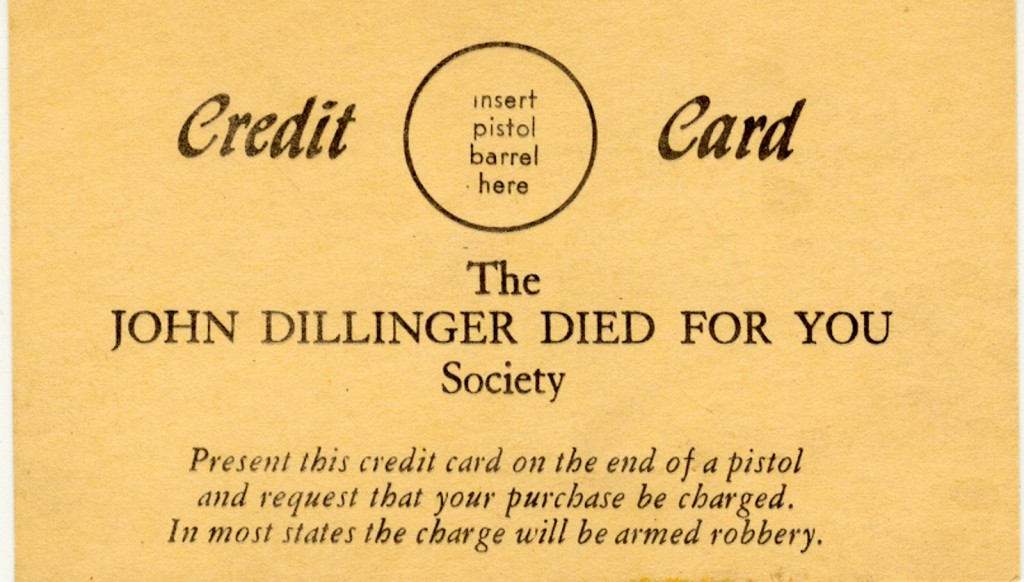
Also, anyone in the Society could convene a meeting at any time, so long as they left one chair empty for the “Dear Departed Member.” (This would be Mr. Dillinger, of course, although some believed that it referred to his supposedly impressive Private Member, which the Smithsonian still insists it doesn’t have and refuses to display.)
In any case, we had our first official meeting at my residence (a one-time Elks Lodge) on East 12th Street in Austin, diagonally across from the state capitol, after which we amused ourselves with a little target shooting in the basement. Soon after that we instituted what we called The John Dillinger Died For You Society Picnic & Punitive Expedition which included a Thompson submachine gun, a case of ammunition, a case of beer, and a case of dynamite, because our host (who had a ranch west of Austin) was big into blowing things up.
As word got around, the Society grew until it could boast some forty or fifty members, and it had become international (I think we had one member in Canada) by the time I moved to Chicago in 1969, where John had fallen. There I encountered other Dillinger buffs (they just didn’t have a society), including two fellow Playboy employees—Bob Shea and Bob Wilson, who just happened to have offices on either side of mine—and were hard at work on Illuminatus!, which ultimately became a cult classic. (Shea would write a chapter that involved conspiracies within conspiracies and then turn it over to Wilson, sight unseen, who would take up the story and elaborate with even more conspiracies. Oddly enough, it held together and actually made sense!)
Needless to say, Shea and Wilson were both Dillinger enthusiasts because of their frequent patronage of the Biograph, and of course I helped them work Dillinger into their story. (Shea and Wilson even mentioned Dr. Naismith as something or other, and me, as the Reverend Mr. Helmer, although the rascals gave me a social disease.)
At the time I was endeavoring to give the magazine its “redeeming social value” by way of the Playboy Forum, which published letters and editorials, and the Playboy Defense Team, with offices in the Playboy Building at 919 North Michigan Avenue (formerly the Palmolive Building); and I fed Shea and Wilson enough Dillinger lore that we soon had not just one but seven Dillingers, thanks largely to a couple of goofy crime-writers who had just co-authored Dillinger: Dead or Alive? (It was our belief that since Mr. Dillinger had been accused of robbing banks all over the country, sometimes simultaneously, he therefore had to employ doppelgängers.)
Meanwhile, I kept encountering more Dillinger buffs, and after a while we began commemorating the passing of John every July 22 at the Biograph Theatre. The management even (grudgingly) cooperated, and that was how I met Richard Crowe, fabled Ghostbuster (I call him), whose several-times-a-week bus tours include Resurrection Mary, Al Capone’s old Lexington Hotel, and, of course, the alley down which the spirit of John Dillinger still walks.
Horace Naismith remained the mysterious master of ceremonies, usually masquerading as an equally mysterious Bill Helmer who maintained an eerie silence, wore a vintage straw boater, steel rim glasses, a pin-striped jacket, and an outrageous 1930s necktie. Mr. Crowe took over the Society, arranging for members (and anybody else) to meet at a nearby tavern and drink themselves into what we’ll call a wake. About 10 PM he would lead his congregation across Lincoln Avenue to the Biograph Theatre (that’s how they spell it) to hear an inspirational speech, after which Mr. Crowe would again lead the way to the nearby alley, accompanied by an honest-to-God, properly-kilted, bagpiper skirling the mournful strains of “Amazing Grace.”
Then everybody (everybody who could remember the words) joined the piper in that sad song because—we again have to presume—John would have wanted it that way.

I, under the nom de guerre Horace Naismith, have since “passed the torch” of The John Dillinger Died For You Society to Mr. Crowe, commonly known as Col. Richard Crowe. I am confident that the faithful will continue to pay their respects every July 22, commemorating the most colorful outlaw of the 1930s who never personally killed anyone.
Well, maybe one, but the cop had refused Dillinger’s admonition to stop bouncing slugs off his bulletproof vest–if it was in fact John, for he only was accused, but never had time to stand trial. In any case, he shot low, they say, and as the officer fell, one slug stuck him in the chest. When John himself later was killed, shot in the back, his pockets yielded a mere $7.71, no doubt because some $20,000 in “git” money had been stolen from his pocket by a rogue cop from East Chicago who had set up the shooting because he had been getting it on with Ana Sage, our “Woman in Red.” (Ana later confirmed that she had seen John count out the money at her place before they went to the movie).
Let’s all remember that Mr. Dillinger was crooked but not twisted, and that he disapproved of unnecessary violence. Unfortunately, he had some colleagues who did not share his otherwise conventional (if somewhat flexible) Family Values.
Remember:
William J. Helmer, 1992
“Two willowy blondes walked nude down Market street yesterday, hand-in-hand with a naked dwarf who had a peg-leg and a beard.
“The three of them, at the height of the evening rush-hour traffic, commanded considerable attention.
“They said they were soldiers in the Om United New World Nude Brigade, whose objective is to free mankind from 6000 years of sexual guilt…”
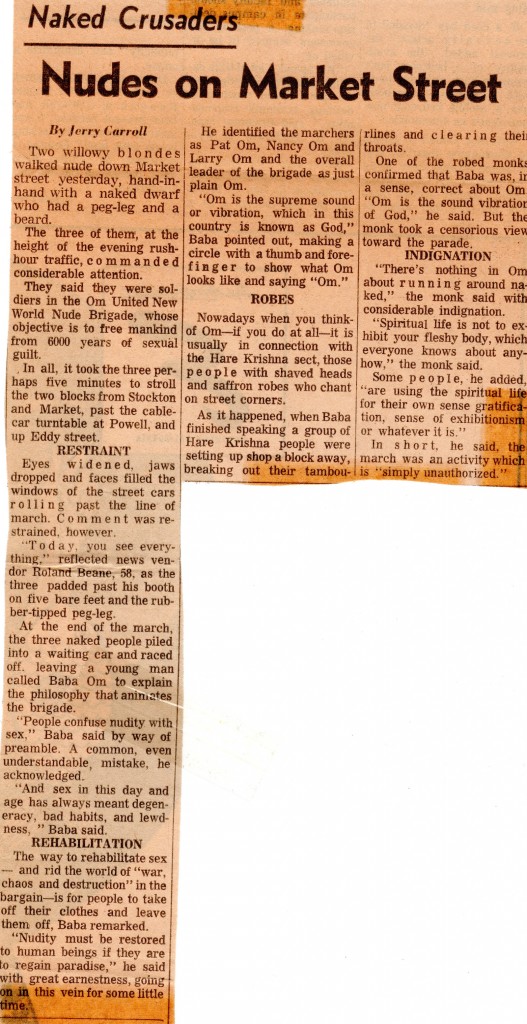
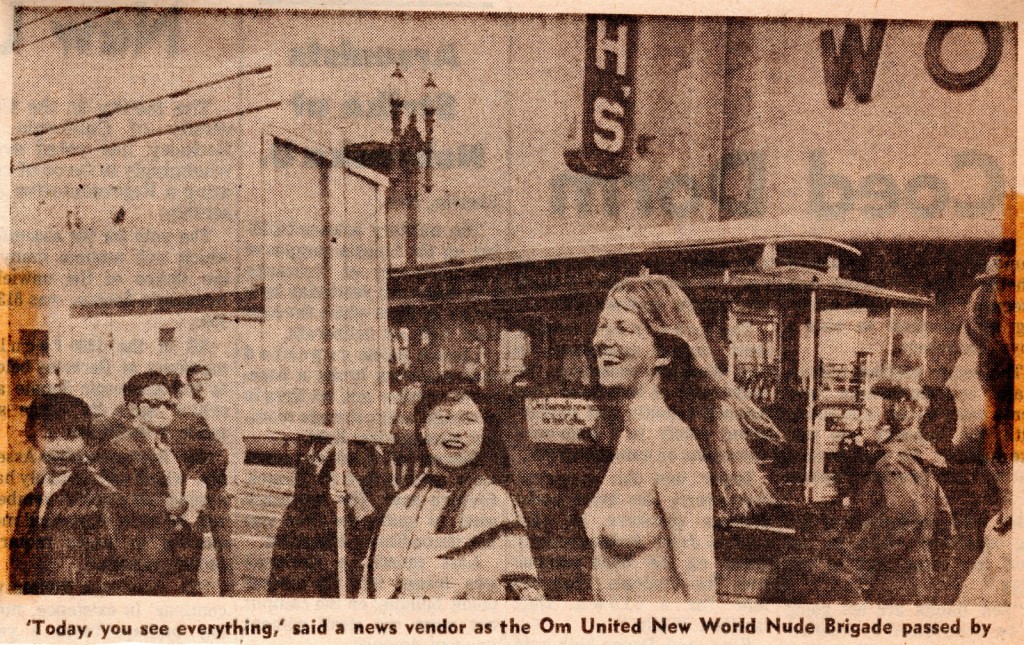
This public display was all part of a “Go Nude Now” campaign sponsored by the OM United New World Nude Brigade (OUNWNB), overseen by the great religious leader, Baba Om, according to the group’s propaganda.

Greg Hill (under the guise of Dr. Ignotum P. Ignotius) sent five pope cards to Baba Om, “the girls and the little fellow, plus one extra on general principles (to accord with the Law of Fives)…”
In addition to a sermon on the benefits of chaos, Doc Iggy congratulated “OUNWNB for your masterful positively–directed-disorder, by parading about the streets baldassed naked, with magnificent effect!”
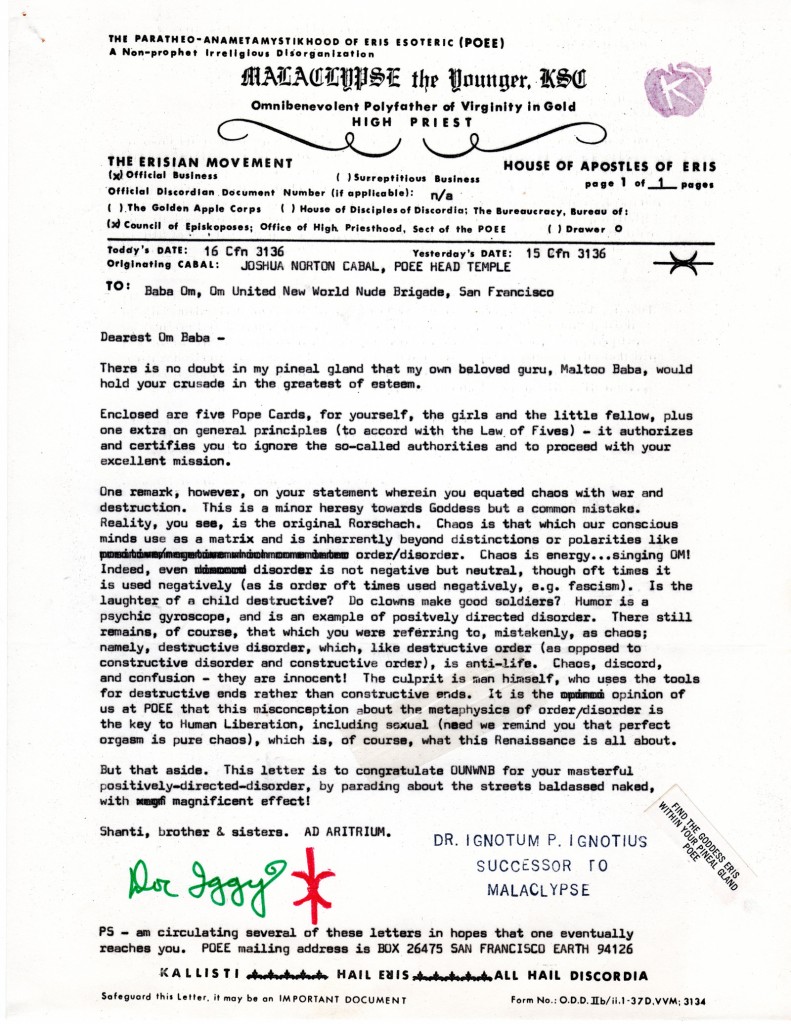
To commemorate this auspicious occasion, the Joshua Norton Cabal issued the following proclamation:
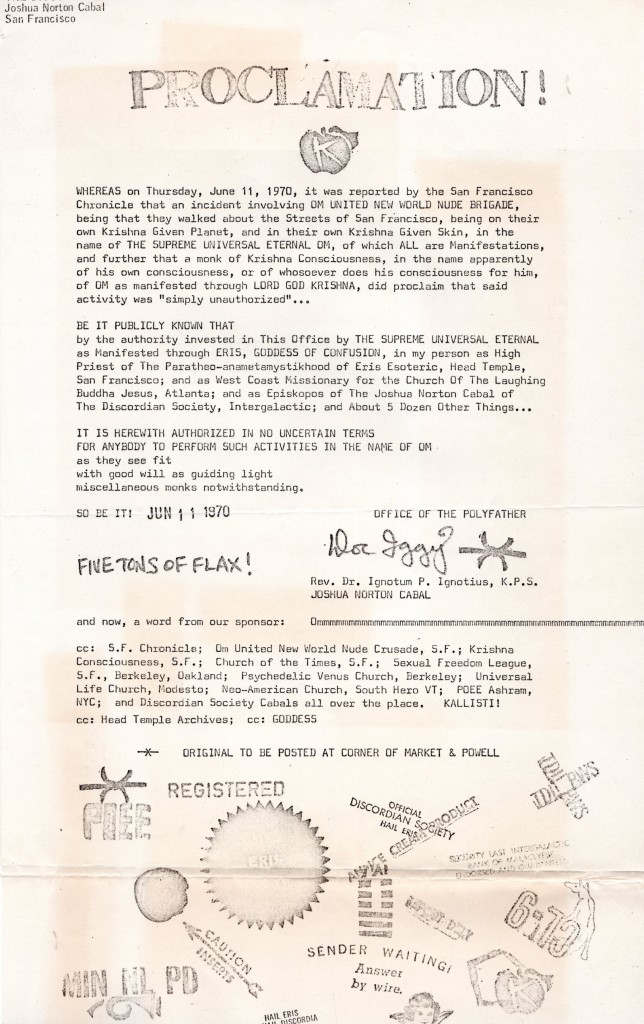
This was today in Discordian History.
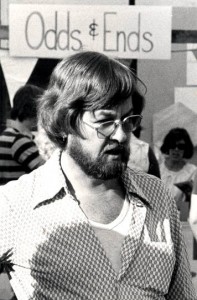
Before proceeding, I thought a short recap was in order.
Roger Robert Lovin was born in Knoxville, Tennessee on May 11, 1941—although there’s conflicting evidence which suggests that his birth name was actually Watlington, and that he later legally changed his name to Lovin. (More on that kink in the thread later…)
According to the bio page of Lovin’s Sci-Fi novel Apostle, he was “a minister of the Gospel at age 16,” although I certainly wouldn’t take Lovin at his word for that—but on the same hand I could totally see him doing the whole Marjoe Gortner teen preacher trip as a young lad growing up in Tennessee.
The first verifiable documentation we have on Lovin dates to 1962 when he was drummed out of Navy for stealing “a television set from a Naval Ammunition Depot in North Charleston, S.C.” Lovin later admitted to assassination researcher Harold Weisberg that he’d been “kicked out of the Navy for a homosexual offense.” Afterwards, Lovin moved to the New Orleans’ French Quarter and cultivated the image of a bohemian renaissance man who—at one time or another—was a performing musician, painter, writer, and all around raconteur. Lovin also claimed to be a soldier of fortune who had smuggled guns into Cuba.
Lovin managed a coffee house/art gallery in the French Quarter where he’d occasionally stage happenings and—as the beatnik scene segued into the hippie era—he adopted all the trappings of the times, growing long hair and dabbling in psychedelics and free love whenever the opportunity availed itself, which as we’ll soon see was frequently and in great abundance.
Lovin was married for roughly three years to a woman named Sandra Bankson, who I really haven’t found out a whole lot about, other than she was employed as a professional dancer.
In-and-around 1964 or 1965, Lovin became friends with Greg Hill and Kerry Thornley and—along with bohemian scene maker Barbara Reid—was one of the early members of the New Orleans’ Discordian Society, and after Hill and Thornley split New Orleans, Lovin became the official head of the Discordian Society’s French Quarter cabal.
Due to his Discordian connections, Lovin came to the attention of Jim Garrison as a potential suspect in his investigation. Lovin passed along some Discordian materials to Garrison via Harold Weisberg and—probably due to this—Garrison came to suspect that the Discordian Society was a CIA front involved in JFK’s assassination!
In 1968, Lovin started the first New Orleans alternative newspaper, The Ungarbled Word, which pretty much brings us up to speed… So away we go!
Jean Marie Stine (then known as Henry Stine, prior to changing gender identity) first encountered Lovin in New Orleans in early 1969. When Lovin learned that Stine was the author of Season of The Witch, he was exuberant with praise for the book, overwhelming Stine with his intensity and charm. A short time later, Stine heard that Lovin was the editor/publisher of The Ungarbled Word and made an appointment to discuss a writing gig.
After arriving at the scheduled time at Lovin’s French Quarter office, Stine was informed by Lovin’s secretary that, although Roger was in, he might be delayed a bit as he was presently ‘busy’ with a young woman there seeking a job. Lovin—the secretary explained—was quite the accomplished pick-up artist who successfully scored with every woman he ever hit on, and—due to the fact he inevitably hit on every attractive woman who crossed his path—it was likely that he and the young lady were having sex in his office at that very moment. An hour later, Lovin came out with the girl on his arm, and afterwards during their meeting confirmed that indeed he’d been doing the ol’ bump-and-grind while Stine waited patiently outside.
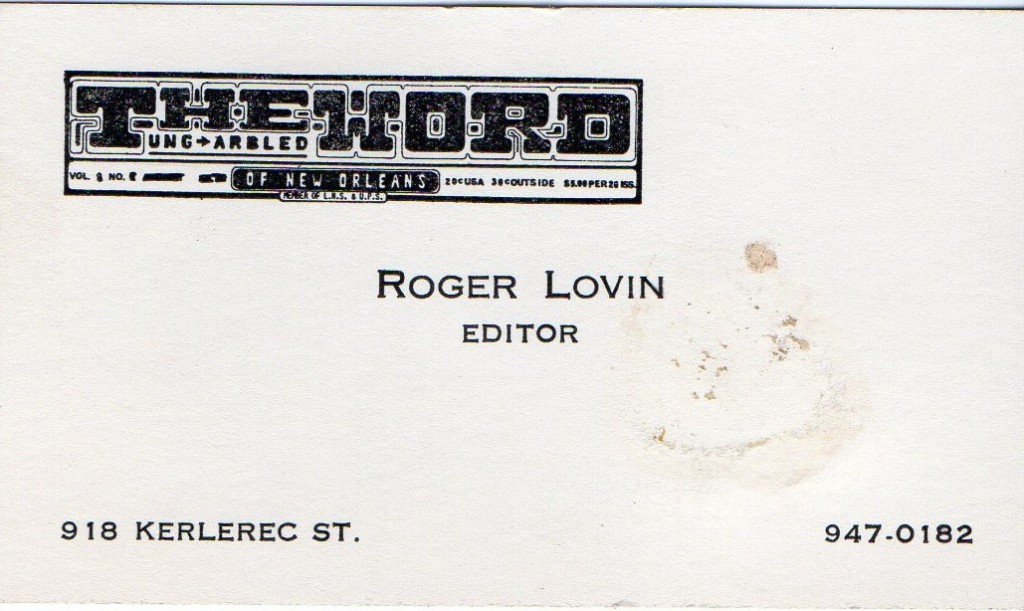
One night—while Stine and Lovin were making the rounds of various French Quarter bars—the subject of Jim Garrison came up and Lovin revealed that Garrison and his investigators were trying to build some sort of sketchy case against him using doctored evidence which included a photo that had been touched-up to make Lovin more resemble another suspect in the case.
Oddly enough, this scenario is strikingly similar to what occurred to Kerry Thornley when Harold Weisberg (using Garrison’s official District Attorney stationary) contracted a California artist to touch-up a photo of Thornley to make him more resemble Lee Harvey Oswald and bolster the theory that Thornley was one of the notorious Oswald doubles. When I mentioned this to Stine, she was quite taken aback and insured me that she wasn’t confusing or conflating the Thornley photo touch-up caper with what had occurred to Lovin, and that these were two separate incidents.
Early in 1969, a bookkeeper working for Lovin ran off with The Ungarbled Word proceeds. In order to keep things afloat, Lovin resorted to selling a stake in the paper to a couple of local characters who not long afterwards attempted a hostile take-over. Part of the plan of these interlopers was to install pre-gender-transition Hank Stine as the new editor/publisher, but when Stine clued Lovin into this planned coup, Roger immediately withdrew whatever Ungarbled Word funds were in the bank and along with Stine, and another writer named Alice Ramirez, (author of The Geek), the three high-tailed it out of town, eventually making their way to Los Angeles.
Shortly after arriving in L.A.—as Stine recalled—Lovin was literally starving, and to keep three square meals coming his way each day, he sweet-talked three waitresses (from three different restaurants) into bringing him food. One of the waitresses worked the morning shift; another work the afternoon shift; and a third, the night shift. And so—according to Stine—each brought meals to Lovin at different times—morning, noon and night—and, of course, Lovin would have sex with each of them during their visits.
A couple years later, Stine recalled visiting Lovin at his Hollywood apartment and was amazed to see a large chart Lovin had put up on the wall to keep track of all the women he was seeing, a system devised to schedule his revolving door of lovers. There have been some online estimates that Lovin bedded down somewhere in the area of around two thousand women. However, Jean Marie Stine suspects it was probably a far larger number, more in the range of ten thousand… and we’re not even talking about the under aged ones yet!
If there was ever someone destined to write a 1970s “How To Pick Up Chicks” book, it would have been Lovin. And who knows, he very well might have (under a pseudonym). During his Hollywood days (1969-1973), Lovin worked in the smut industry as an editor for American Arts, which had several different imprints, and it was through one such imprint he published his novel Eleven (1970), which included this cover blurb: “Eleven by Roger Lovin is an unnatural twist on the Lolita syndrome, the story of the love affair between a three-hundred-pound man and an eleven year old girl, a grotesque situation which Lovin handles with understanding…”
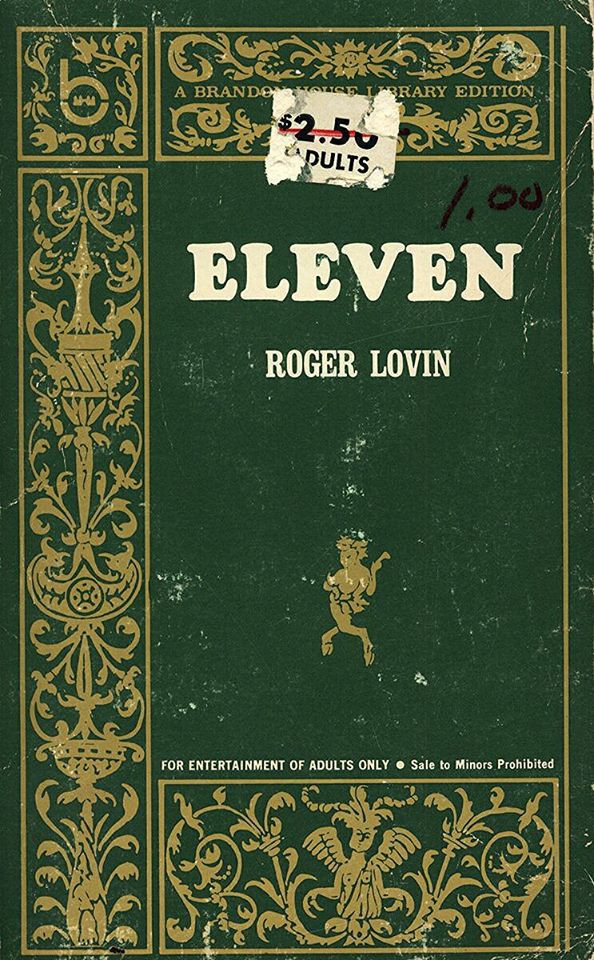
At the time—as Stine recalled during our recent interview—none of Lovin’s friends suspected he had a thing for underage girls, and most assumed Eleven was simply just his spin on a taboo subject. Later, it would become evident that the roots of Eleven were much more than a mere fictional flight of fancy and had real world implications.
In 1974, Little, Brown and Company published Lovin’s opus, The Complete Motorcycle Nomad.
Released as a Sports Illustrated selection of the month, it’s still considered by many motorcycle enthusiasts as a classic in the field.
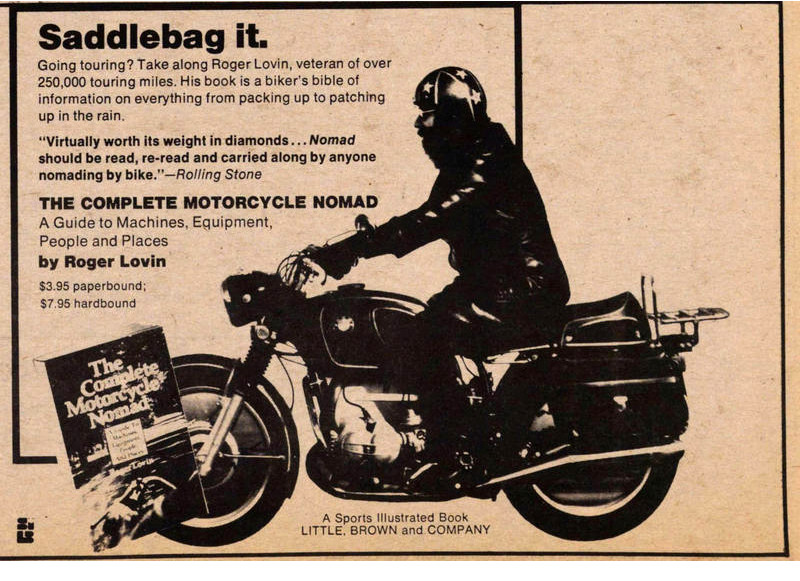
My first inkling of Lovin’s illegal activities came by way of a news clipping (I’d stumbled upon in the Discordian Archives) from the science fiction fanzine Locus, the gist of which stated that Lovin had been arrested on “four counts of contributing to the delinquency of a minor, four counts of aggravated crime against nature, one count of carnal knowledge of a juvenile, and three counts of indecent behavior with a juvenile…” Lovin had been “released on $2,500 bond after being charged Oct.22 [1979] with possession of pornography…”
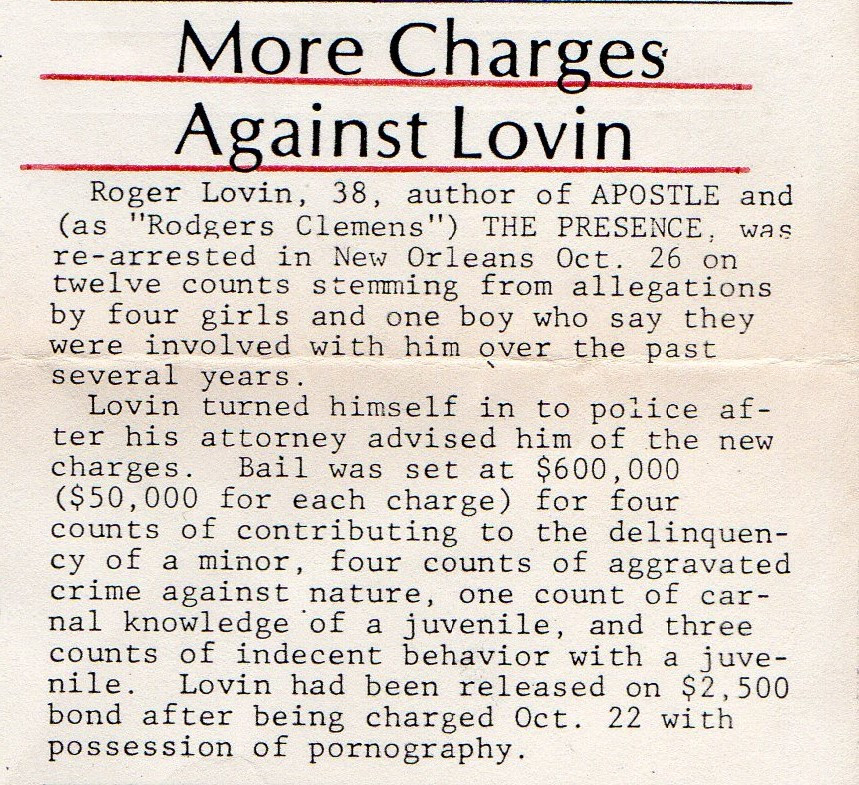
At the time, I wasn’t quite sure what to make of these allegations. Nor did I have any other background on Lovin, so it was hard to know how deeply he was really into any of this, or if it was simply an isolated incident of showing pornography to some kids, or perhaps an instance of poor judgment in regards to having sex with an underage girl.
My curiosity about Lovin persisted over the years, and when I’d occasionally stumble upon some item related to him in the Discordian Archives, it would inevitably lead to a web search. About ten years ago or so I happened upon this thread at ancestry.com where a woman—who suspected Lovin was her biological father—was seeking further information on him. The thread (from 2005) consists of around thirty entries, many from people who claimed to have known Lovin, some of whom said he had gone to prison for pedophilia.
A post from someone claiming to be Lovin’s sister (going by the name of “Freewind143”) stated that she and her other family members “were never made aware” of any criminal charges against her brother, and that Roger had been sterile and never fathered any children. Freewind143 noted that he “died in New Orleans on November 1, 1991.” Along with her post, Freewind143 shared a photo of Lovin with two of his sisters. The photo did indeed appear to be Roger Lovin—probably in his mid-to-late 40s—which would have put the timeframe the picture was taken around the mid-to-late 1980s.
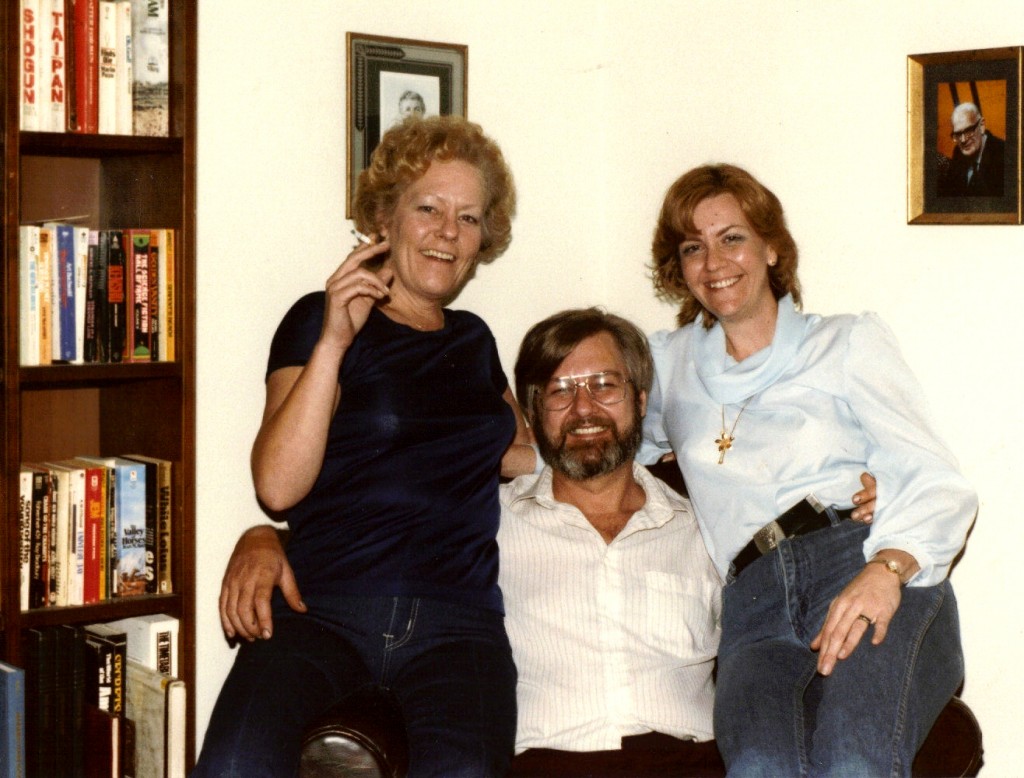
My friend Tim Cridland (aka Zamora the Torture King) has been of immense help in untangling this twisted Roger Lovin web… a web which still may have a few tangles in it yet! Tim, like me, possesses an unnatural interest in many odd and arcane tributaries, and the people who inhabit many of these strange lanes, such as the colorful French Quarter characters associated with the New Orleans Discordian Society, including Kerry Thornley, Barbara Reid and Roger Lovin. In his role of Zamora, Tim travels around the world performing feats of wonder, and on his off hours often haunts local libraries and other repositories of ancient knowledge. While in New Orleans last year, Tim was able to lay his hands on some Roger Lovin related news clippings which provided further confirmation that Lovin had indeed been arrested and charged with the crimes mentioned in the Locus article.
According to October 25, 1979 edition of the Baton Rouge States-Times Advocate, “A self-styled preacher and part-time writer has been arrested in a raid at his apartment where thousands of pornographic pictures of young girls were seized….[Police information officer] Gus Krinke said the photographs depicted nude and partially nude girls, sometimes involved in sexual acts. He said most of the girls were runaways, but others came from fatherless homes in New Orleans… police said Lovin’s apartment was equipped with a darkroom enabling the film to be developed and printed there… Some of the girls may have posed for Lovin, officers said, after he convinced their mothers he simply wanted them for models.”
The October 25, 1979 New Orleans Times-Picayune stated that—following Lovin’s arrest—the police were “conducting a massive search for the identities of as many as 500 young girls who are believed to have been intimately involved with a man arrested here for possession of pornography” and that “Lovin may have been involved in a pornography network which stretches across the country… Lovin found many of his subjects by attending young people’s functions… police have proof he lured one of more of his victims away from a recent science fiction convention.” The article went on to state that Lovin was “originally from Tennessee” and “legally changed his name from Watlington to Lovin.”
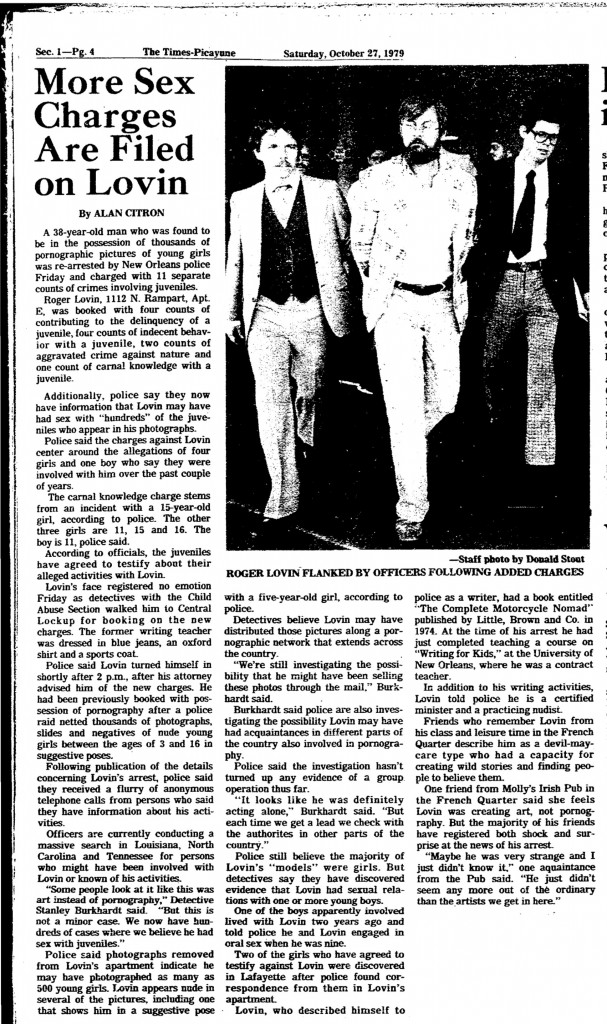
According to the October 26, 1979 edition of the New Orleans Times-Picayune:
One woman who took his course on “Writing for Kids” at the University of New Orleans, said he was an excellent teacher who never missed class.
“He was a very smooth talker,“ the woman remembered. “he gave the impression of being a very intellectual type person.
“He seemed to be a devil-may-care type of bachelor. But he was very balanced.”
The woman added, however, that it was obvious he wasn’t a run-of-the-mill type of person.
“Some of the things he said were a little strange,” she remembered. “But I wasn’t offended. Some of the older ladies were a little bit offended by his choice of words, but it was never anything serious.”
The former student said she wasn’t shocked when she heard the news, but was surprised that he could lead such a dual life.
“I got friendly with the man,” she said. “He didn’t seem like an absolute pervert. He just wasn’t like that.
“He made it clear several times that he wished he was in bed instead of in class because he had had too much to drink the night before. But he was always there.”

According to Jean Marie Stine, at the time of Lovin’s arrest he lived in an apartment complex at 1112 N. Rampart St., and in a room across the hall lived a friend of Lovin’s who was an illegal arms dealer—which brings legendary Science Fiction author Norman Spinrad briefly into the story. Spinrad—also friends with Lovin—took a cross country trip with him in the mid 1970s, and part of their travels included a stop-over in the French Quarter. It was there that Spinrad was introduced to Lovin’s neighbor (the guy with all the guns) and this fellow took Spinrad for a ride up in the woods where he demonstrated some sort of rocket launcher, which completely blew Spinrad’s mind. Anyway, this same fellow was later raided by the cops for unregistered firearms. During the raid—when Lovin attempted to intervene on behalf of his friend—the officers told him to back off, pushing Roger back into his own apartment, where they observed photos of nude young women (and very young girls) posted on the walls. In short order, the cops got a warrant and raided Lovin’s apartment, leading to his arrest.
To friends, Lovin presented his side of the story that, yes, he’d had sex with underage girls, many that were runaways from broken homes home to whom he’d provided shelter and a warm bed, and without his ‘guidance’ they would have been out on the streets hustling sex for drugs or money. Lovin further insisted that he had taken these wayward youth under his wing with the consent of their parents, who were well aware of his sexual proclivities. During this period, Lovin was passing himself off as a “minister” of some sort, which might have been yet another ploy he used to ingratiate himself with both the parents and their children. Most of these parents were the girl’s mothers, who Lovin presumably charmed with his notorious silver tongue.
Newspaper reports and other accounts I’ve come across alleged that some of the girl’s parents had given Lovin permission to use them as photographic ‘models.’ After Lovin’s arrest, police detectives tracked down a number of these parents and pressured them into signing a criminal complaint against Lovin or face being charged with child endangerment.
Another spin Lovin put on the story was that his arrest had been orchestrated to cover-up a deeper NOLA scandal related to government officials caught having sex with underage boys. The intent of this cover up—according to Lovin—was to create a media distraction while behind the scenes the officials were let off the hook with minor offenses, the details of which were buried in the back pages while Lovin’s arrest was the front page news.
Jean Marie Stine felt there might have been some measure of truth to Lovin’s conspiracy theory. At the time, Stine was living in Baton Rouge and remembered reading the initial news reports about this government-officials-in-bed-with-boys-scandal, but then suddenly it all but disappeared from the front pages and was apparently swept under the rug at the exact time Lovin was facing his own legal kerfuffle.
According to Stine, the story became ever more tangled after Lovin’s trial, which should come as no surprise given Louisiana’s long history of political corruption. As it turns out, Lovin never actually served time in prison, but was in lock-up at the city jail for a period of time awaiting sentencing. According to Stine’s sources, an anonymous Lovin supporter—who suspected that Lovin would probably never make it out the Louisiana prison system in one piece—offered a sizable sum to the judge presiding over the case in the form of a “political contribution.”
The judge—as the story goes—was seeking an office in a higher court, which was apparently an elected position, and ultimately the “contribution” was accepted. These negotiations took place over the course of several months, and in the meantime Lovin’s stay in city jail—while not as bad as prison—was no cake walk, either. In fact, the first few weeks proved to be pretty rough, until one day when he was approached by a member of the Louisiana chapter of the Hell’s Angels. As it turned out, the Angels were big fans of Lovin’s The Complete Motorcycle Nomad and—after discovering that HE was THE “Roger Lovin”— let him know they “had his back” and from that point forward nobody messed with Lovin during the rest of his stint in jail.

When all was said and done, Lovin was granted a suspended sentence, which consisted of something in the area of five years probation. The terms of the probation dictated that he could neither leave New Orleans nor have any contact with juveniles. Lovin managed to stay on the straight and narrow for the court-ordered term, and after his probation ended—somewhere in the mid-to-late 1980s—he started making frequent trips to Belize where he could have sex with underage girls and not worry about the consequences. According to Jean Marie Stine, Lovin eventually ended up living fulltime in Belize and the last she heard was that he’d died sometime in the early 1990s.
A while back, Tim Cridland came across Lovin’s Social Security number on an old FBI memo. When Tim ran it through the online Social Security Death Index, it come up with no results for Roger Lovin… or any one named Watlington, for that matter. Tim hunted for death notices and obits in the Louisiana newspapers—as well as searching local cemetery records—but was unable to find any confirmation of Lovin’s death. The only thing definitive we had in that regard was the statement by “Freewind143” (on the Ancestry.com forum) who claimed that her brother had “died on November 1, 1991.”
However, some of Freewind143’s other comments didn’t quite jibe with the known facts, including her claim that neither she nor other family members were aware of criminal charges. Freewind143 also noted that “Roger Lovin” was her brother’s real name, which contradicts the NOLA newspaper articles that reported Lovin had been born with the last name of Watlington and later legally changed it to Lovin. Lovin first mentioned his name change to Clarence Doucet of the New Orleans Times-Picayune in a January 13, 1974 interview. An October 25, 1979 article in the Times-Picayune confirmed that “Records show Lovin is originally from Tennessee. He had his name legally changed from Watlington to Lovin.”
Given these discrepancies, Tim started entertaining the notion that perhaps Lovin had never actually died. I also began to suspect that Tim might be on to something, and that “Freewind143” may have been intentionally muddying the waters. Going out even further on this limb, the thought entered my mind that maybe Roger Lovin himself was posting as Freewind143!
Freewind143 noted that her brother had been sterile, this in response to the woman on the thread who was trying to figure out if Lovin was her biological father. Assuming Lovin had already changed his name once before, I began to wonder if this was yet another instance of creating a new identity to distance himself from the past, and that Lovin’s move to Belize was also part of this disappearing act.
Like her brother, Freewind143 is a writer, and using the pen name of “Freewind Gingerblaze” has authored three fantasy titles.
Freewind’s books could be considered in Lovin’s literary wheelhouse, as he was an author of one Science Fiction title, Apostle, and had written a couple more Sci-Fi/Fantasy manuscripts that were never published. Could these “Freewind Gingerblaze” titles have been the previously unpublished Lovin novels?
Another web search revealed that Freewind Gingerblaze’s real name is Molly Bressette, formerly Molly Annis Lovin. (On the Ancestry thread, Freewind143 noted that some of her family members call her Ann because her middle name is Annis.)
Googling “Molly Annis Lovin” led to a couple pertinent links here and here that appear to confirm her story.
Of course these findagrave.com entries could have been easily fabricated, but it seems like a lot of effort to go through (concocting an entire family tree) unless someone was really intent on faking their own death. Not that I wouldn’t put it past Mr. Lovin, who always seemed to have something up his sleeve. With all that being said, I’d wager that the name change switcheroo—from Watlington to Lovin—may have been Lovin pulling the leg of reporter Clarence Doucet back in 1974, and later this name change story was repeated (without fact-checking) during the Times-Picayune’s reportage of Lovin’s arrest in the fall of 1979. Just the same, it certainly seems curious that Freewind143—and other Lovin family members—“were never made aware” of her brother’s criminal history.
Thanks again to Tim Cridland for his invaluable contributions to this craziest of all stories. Check out Tim’s Off The Deep End blog for more related madness, including his evolving series on Rev. Raymond Broshears.
Also, check out my interview with Jean Marie Stine about Roger Lovin embedded into this web page below, or, you can listen on your preferred new fangled whatever SoundCloud podcast harvester via my new podcast show called Radio Gogo with Adam Gorightly.
Follow me on SoundCloud, you’ll deliciously regret it!
Also, Millennials, share with your parents via Facebook, Instagram, whatever is hip now, they desperately want to understand what you’re into, so throw them a curve-ball that will not only educate but also confuse them!
And lastly, you can download the Lovin Files (for supporting documentation) here.
Hail Eris!

As part of his official duties overseeing the Confusion Contest, Rev. Dr. Occupant issued the following report:
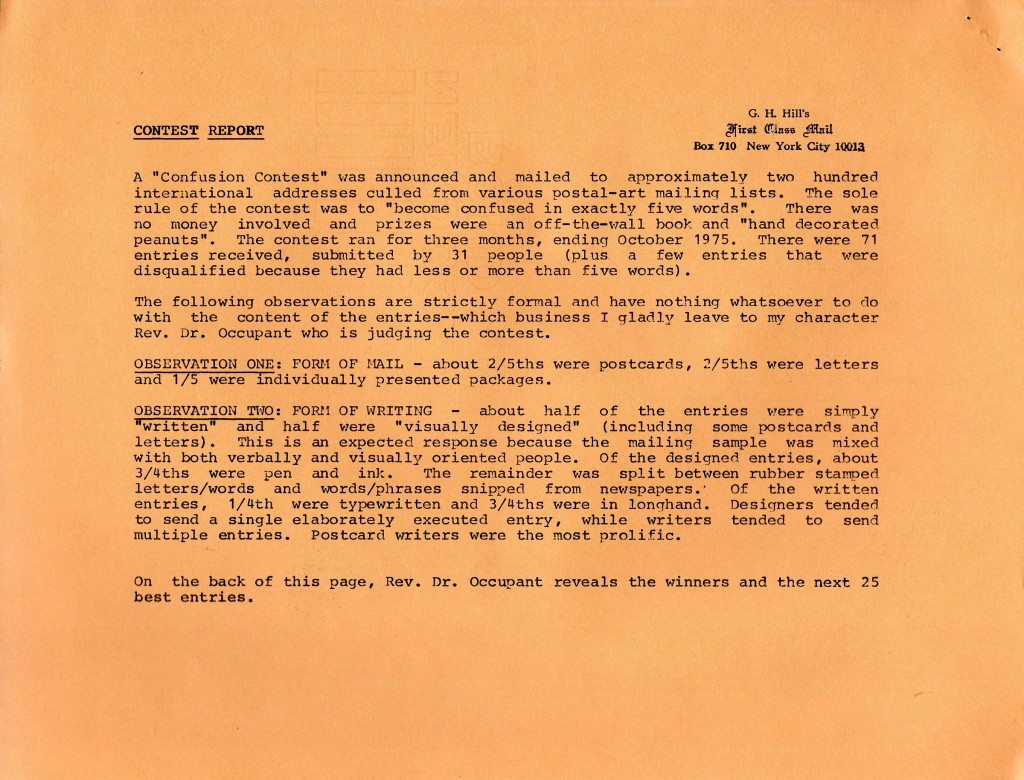
And drum roll please…
Here are the winners of ConCon 75!
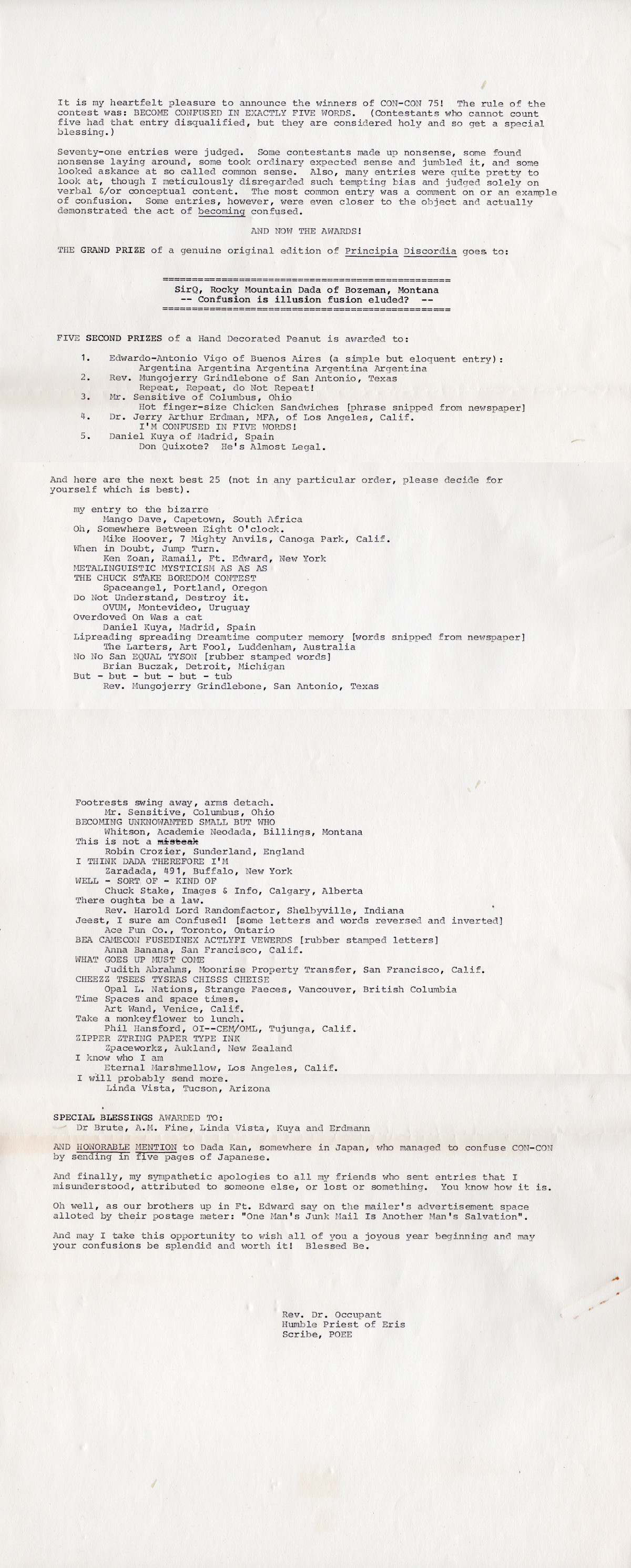
One of the ConCon entries “came” courtesy of Discordian poetess and one-time lover of Kerry Thornley, Judy Abrahms.

Here’s another ConCon entry promoting “Hot finger-size Chicken Sandwiches.”
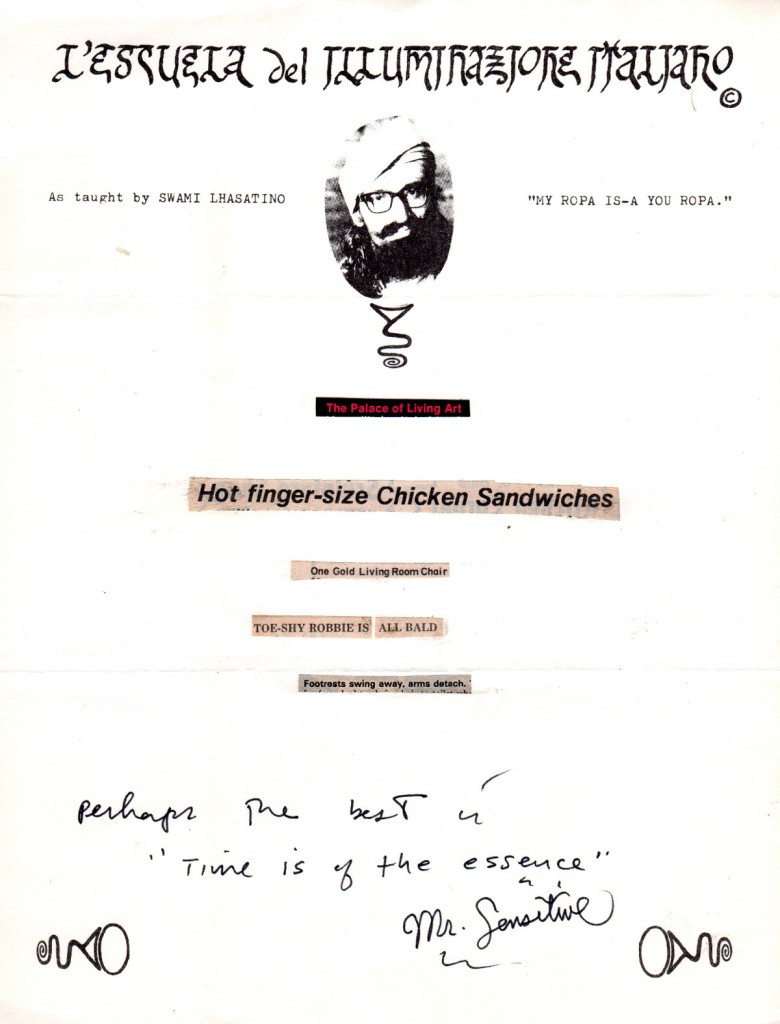

at Discordian Archives West hindquarters.
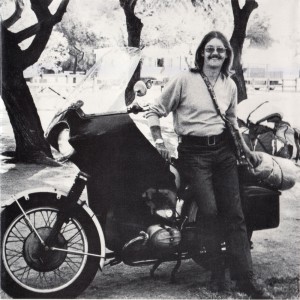
As anyone who frequents this site is well aware (or has bought my books—yes, please buy my books!), Garrison targeted Kerry Thornley as part of a supposed sinister assassination cabal centered in the New Orleans’s French Quarter. The key witness against Thornley—in this regard—was Early (and squirrelly) Discordian Barbara Reid, who most likely imagined or confabulated or conflated her claims against Thornley as a means to launch herself into Garrison’s orbit.
Our previous series on Barbara Reid can be found here and here for those with a need to get up to speed on Reid. (See what I did there?)
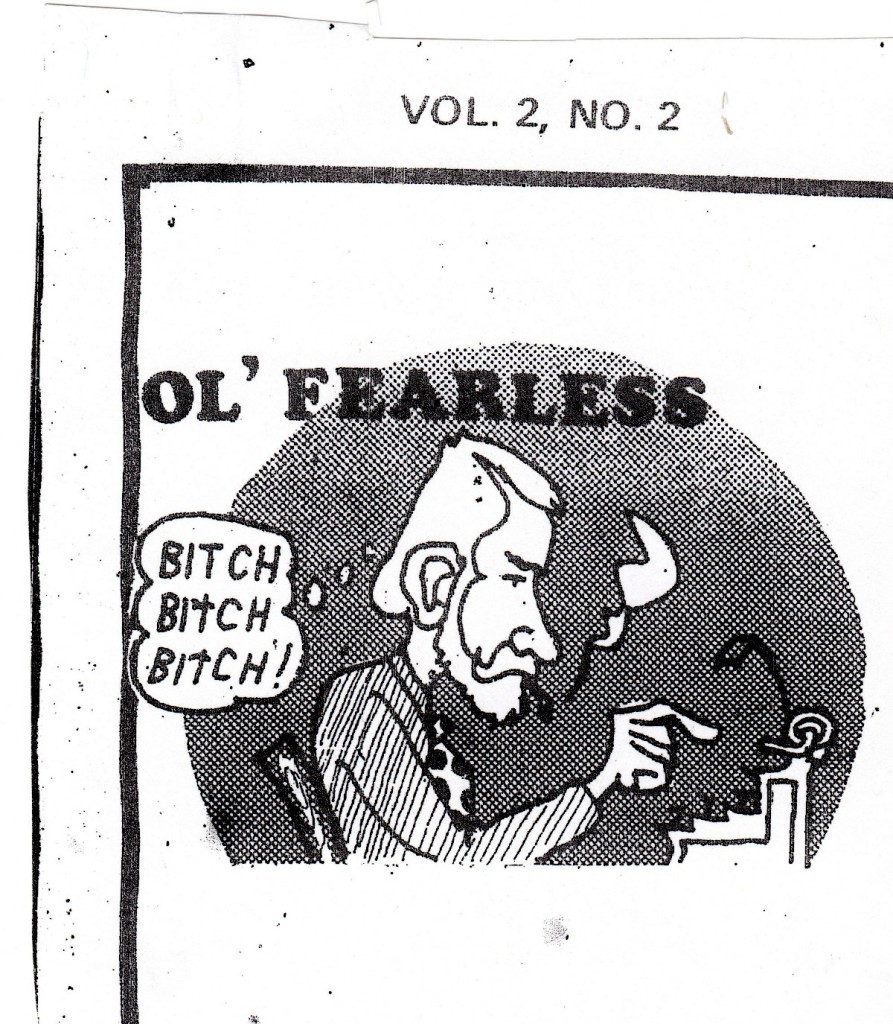
In his March 1969 column in The Ungarbled Word (the underground French Quarter newspaper Lovin published), he wrote this about Reid:
“Prominent among Garrison’s self proclaimed informers is one Barbara Reid… a self-proclaimed witch who maintains a “Voodoo” altar in her French Quarter home. She has a long history of two-faced dealings, and has been known to sell information in return for “favors.” She is, she claims, Jim’s ear in the quarter…”
The key figure investigating Lovin’s supposed connections was assassination researcher Harold Weisberg whose skullduggery we’ve previously examined in great depth here, here and here.
Weisberg for awhile was hooked at the hip with Barbara Reid, and it was Reid who no doubt steered Weisberg in Lovin’s direction. Part of their suspicions concerned Lovin’s association with an outfit called the Modern Language Institute that apparently held occasional meetings at the Ryder Coffee House, a beatnik hangout promoting integration and free speech which we talked about in our first installment of this series.
The Ryder Coffee House was a meeting place for all manner of groups, primarily left leaning bohemian types, however its doors we’re open to all, which explains the presence there of the Modern Language Institute (MLI), an organization affiliated with anti-Castro Cubans and other right wingers—or perhaps these right wing elements had infiltrated the MLI, possibly using it as a front organization, or as a means of recruitment into clandestine anti-Castro (possibly CIA funded) activities… I know, it gets deep. And a lot of the information surrounding all of this is ancient and murky. But hang with me.
It was Garrison’s contention (ala Weisberg and Reid) that Lovin and Thornley had attended meetings of the MLI at Ryder Coffee House along with the MLI’s manager, an anti-Castro Cuban named Arnesto Rodriquez. (In some of Weisberg’s memos, he even suggests that Lovin managed the Ryder Coffee House at one point during this period.)
In regards to the MLI, Garrison was all over the notion that anti-Castro elements had been part of a JFK assassination hit team in cahoots with rogue CIA agents and that the likes of Arnesto Rodriguez and Kerry Thornley and Roger Lovin were all wrapped up in these alleged clandestine activities and that MLI served as some sort of cover for covert operations. I tend to doubt there’s much to these theories—at least in relation to Thornley and Lovin—but as anyone knows who has looked into this arcane history, nothing is cut-and-dried, and both Thornley and Lovin indeed had some curious connections with many of the shadowy figures who inhabited the French Quarter during those wild and wooly days. Whether, ultimately, these connections had any direct bearing on JFK assassination conspirators is still a matter of vast conjecture and conspiratorial fodder.
Harold Weisberg described Lovin as a “beatnik-type painter from Slidell, LA… who had run guns to Cuba for profit.” Weisberg was informed by Arnesto Rodriguez that he “was moving his school [Modern Language Institute] from across 6th street at the end of July 1963 and early August, that [Rodriguez] did not immediately finish up the back room, and that he agreed to a Lovin proposition that, in return for fixing it up, Lovin be given the use of the space for a studio. Arnesto says that on an unexpected return to the suite on a Sunday he found a naked Lovin convorting [sic] with a naked girl and thereupon terminated the arrangement for the space…”
As we learn more about Lovin, this anecdote is perhaps the first instance (in this series) of pulling back a curtain that will reveal much more about his veracious sexual appetite.
According to another memo by Harold Weisberg:
“LOVIN was connected with an organization known as Services Unlimited, care of the Bourbon House Bar in New Orleans, La. The Organization will allegedly do anything for money: i.e., fly a plane, steal property, paint a house, surveil individuals…Lovin claims to have been in jail in the state of Georgia for smuggling arms to Fidel Castro in the Sierra Mountains of Cuba prior to 1959. Source advised LOVIN claims to have done smuggling for FIDEL CASTRO in 1958 for a few weeks, but is not known to have returned since that time. He is allegedly now anti-Castro.”
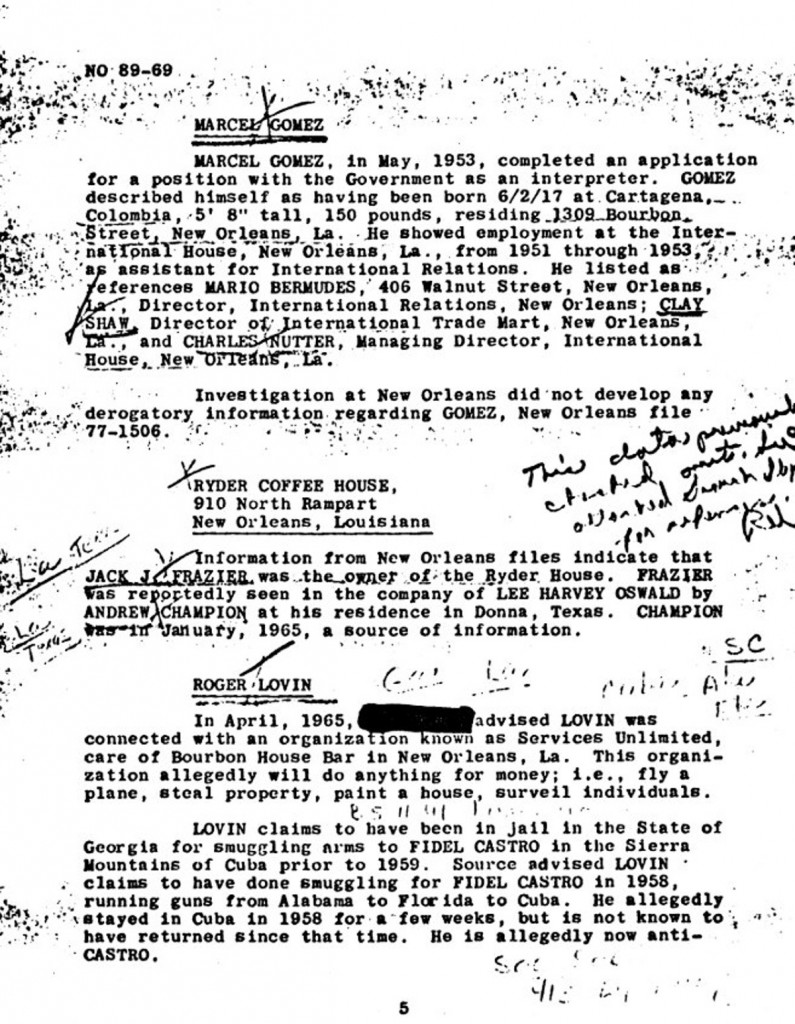
In regards to the charge that Lovin was running guns, this claim apparently came from Lovin himself, and scant evidence exists to support this allegation, other than the real possibility that Lovin made it all up to create an aura around himself as that of a secret agent renaissance man who dabbled in the arts and literature on one hand while at the same time working as a soldier of fortune engaged in covert activities. On the other hand, it’s certainly not out of the realm of possibility that Lovin might have been involved in clandestine capers, as he was indeed a man of many talents, some of which pushed the envelope toward criminality. Just the same, the so-called “Services Unlimited” yarn seems somewhat far-fetched, and sounds like something Lovin might have cooked up over beers at the Bourbon House one night with his friends.
There was also the allegation (once again courtesy of the Harold Weisberg-Barbara Reid tag team) that Lovin and Lee Harvey Oswald had been roommates, this allegation coming (allegedly) from an informant named Bernard Goldsmith. But once again, this sounds like Lovin possibly yanking someone’s chain, or Barbara Reid conflating one thing she heard with another.
The Lovin-related info passed along to the FBI was sourced from a couple interviews Harold Weisberg conducted in 1967 and 1968. According to a Weisberg memo from April 12th, 1968, Lovin admitted that he’d been “kicked out of the Navy for a homosexual offence that he said was isolated but mixed up in another and major case…” This episode might be related to another FBI memo that states: “LOVIN was alleged to have stolen a television set from a Naval Ammunition Depot in North Charleston, S.C. sometime in February 1962.”
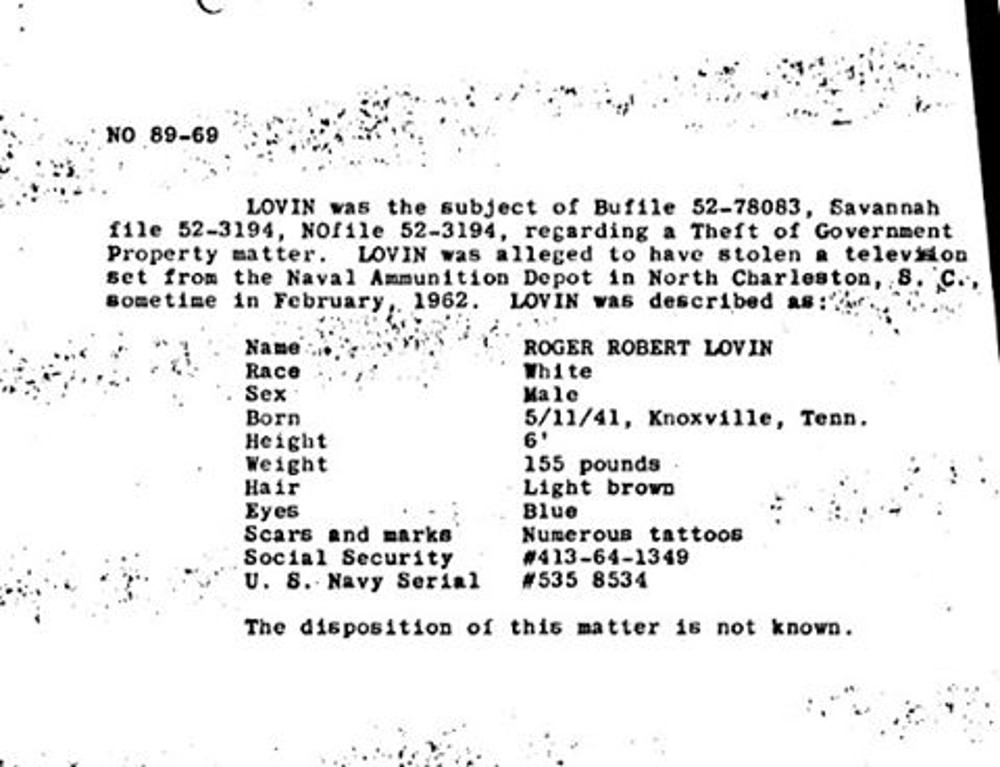
In his column from Feb 20th, 1969 edition of The Ungarbled Word, Lovin had this to say about his interactions with Garrison’s investigators:
“I am, and have been, a close friend of Kerry Thornley. Kerry served in the Marine Corps with Lee Oswald, and Garrison contends that he (Thornley) met and had dealings with Oswald here in New Orleans. In the early days of the investigation, during the initial questioning of everybody even vaguely connected with anybody else, I was asked to come answer questions at Garrison’s office. Louis Ivon, one of Garrison’s investigators, informed me that he had information to the effect that I had, 1. Roomed with Oswald, 2. Sold him a rifle, and 3. Was part of the alleged conspiracy.
“I pointed out that, during the time in question, I wasn’t even in the city and could prove it. Ivon didn’t seem to want to hear that. When I offered to submit to a lie detector test, he was also less than anxious to listen.
“Later, I was twice visited by Harold Weisberg, a writer who represented himself as being from Garrison’s office. He made tapes of the two conversations, took my photo scrapbook, and vanished. He was since written two books on the assassination, both of which have been panned by critics as being far from factual. A year ago, Weisberg sent a letter on Garrison’s stationary to Fred Newcomb, an artist requesting that he retouch a picture of Kerry Thornley to make him look more like Oswald. Newcomb sent Weisberg’s request to the D.A., and got an answer declaiming any connection with Weisberg. Bother letters, Weisberg and the D.A.’s were on official stationary, and appeared to have been typed by the same secretary.
“Also last year, a young girl who was a part-time beer salesman on Bourbon St. and who said she was working for Garrison, tried to pump me for information on Oswald. I laughed at her, and she said “You had better talk. We’ve got a case on you and have ways of making you talk.”
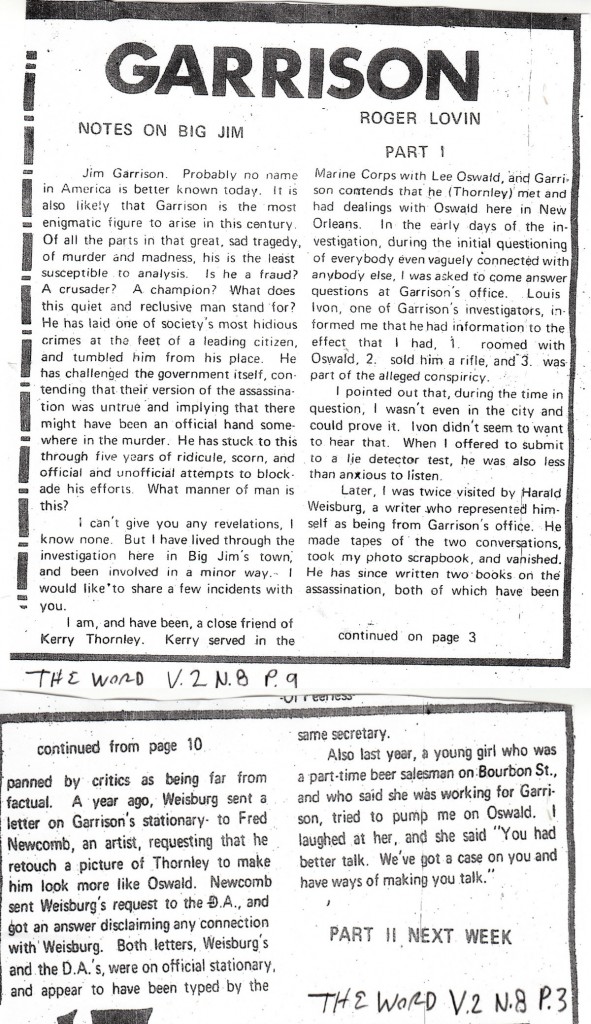
As for the scrapbook (taken by Harold Weisberg) that Lovin mentions in his article, this contained, among other stuff, a sheaf of Discordian material that was enough of a head scratcher to get Weisberg imagining that the Discordian Society was somehow part of his JFK assassination conspiracy wet dream, a nutty notion I covered in some depth in a previous article entitled “Was The Discordian Society A CIA Front?”
But, weirdly enough, the JFK assassination wasn’t the only political assassination that Lovin became associated with—however obscurely. According to another odd FBI memo, in 1964 Lovin had taken dance lessons at the Continental Dance Studio in New Orleans—with the intent of becoming a dance instructor himself—and Lovin’s then wife, Sandra Lovin (né Sandra Bankson), was also involved with the studio as an instructor.
The gist of this FBI memo concerned visits to the Continental Dance Studio (also in 1964) by an individual going by the name of Eric Stavros Galt, which—it turns out—was an alias for James Earl Ray, the (alleged and convicted) assassin of Martin Luther King Jr.
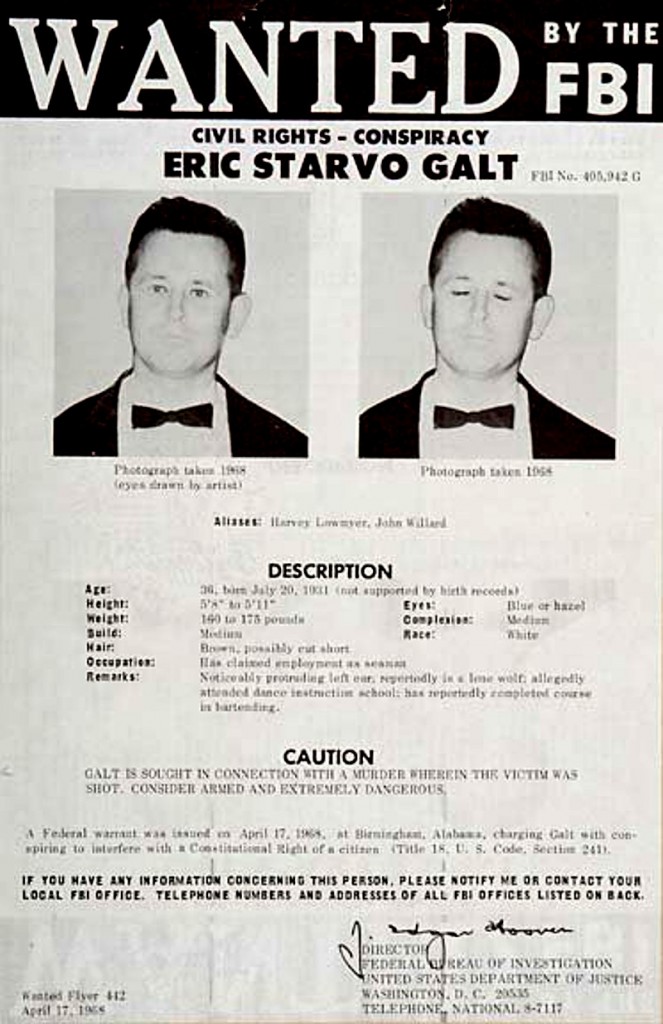
Apparently, Ray had used the Galt alias during the period he received his series of dance lessons, and a couple weeks after MLK’s assassination—on April 19, 1968—the Feds tracked down different people associated with the dance studio to learn what they knew about Ray’s activities. To this end, Lovin and others associated with the dance studio (including his wife, Sandra) were questioned, and it doesn’t appear anything too monumental came out of this, other than the fact that the owner of Continental Dance Studios, Marlin C. Myers, did indeed confirm that Ray (under the alias of Galt) had attended some dance lessons there.
This inquiry seemed to be triggered by an earlier interview that Lovin had with Garrison’s investigators, and as they were showing him different photographs, apparently one of the James Earl Ray/Eric Stavros Galt mug shots was passed to him, and though Lovin didn’t recognize the photo, he said the Stavros part of the name sounded familiar, but that he might have been conflating it with a novel he had read. It all gets a bit convoluted, to say the least, but here’s the memo below, if you wish to get even more confused.
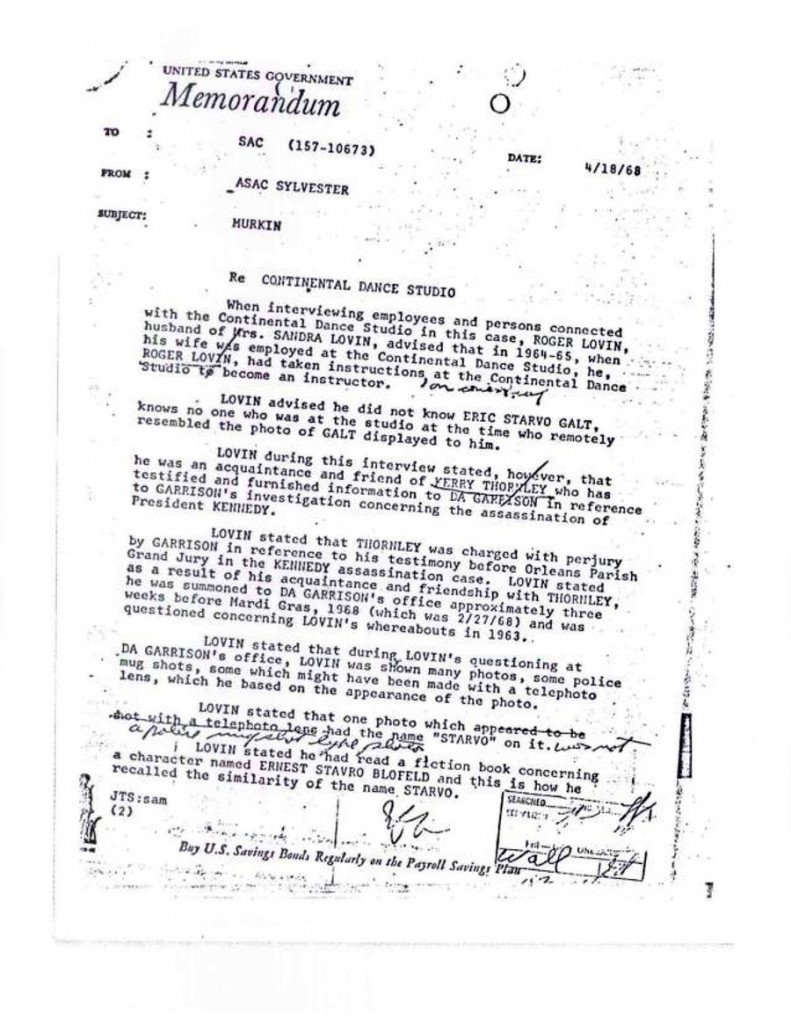
Thanks to Tim Cridland (aka Zamora the Torture King) for unearthing a lot of this information and making my head spin trying to explain it all.
COMING SOON: the Final Installment of this Series (at least I think it will be the Final Installment) which will be a bit of shocker to some, [whisper]containing some rather delicate revelations, as well as an audio interview I conducted a while back with Jean Marie Stine who found herself in the thick of a lot of Lovin’s adventures in New Orleans and later in Los Angeles in the early 1970s.[/whisper]

The first issue was a rather crude, Xeroxed affair and although it came across as amateur in appearance, Balls featured top notch content including an excerpt from one of the first Discordian writings by Bob McElroy (aka Mungojerry Grindlebone) titled “The Gadfly’s Glossary.”

The third issue of Balls:The Ungarbled Word featured an excerpt from Greg Hill’s “Draftee’s Dictionary.” The full version, like Mungo’s “Gadfly’s Glossary”, is part of the Discordian Archives. Links to both are provided here and here.
Ungarbled Word occasionally ran Discordian recruitment advertisements, such as the following:
Sometime in 1958 or ’59 Lord Omar Khyyam Ravenhurst, K.C. was seized by a Mystic Fit. When he revived, he stammered, “How blind we have been. All of this confusion could not just have HAPPENED! SOMEBODY had to PUT all this discord here!” Whereupon Malaclypse the Younger, K.C. had a vision of Eris in which she gave him instructions quite incompatable with those received by Lord Omar, and the DISCORDIAN SOCIETY was born.
SINCE THEN, membership has more than tripled, and the Society has been brought to dynamic Discordian perfection by Fang, the Unwashed, W.K.C., etc., and Mungojerry Grindlebone, C.T.E., etc.
THE DS is the hottest item to hit the holy market since Islam. If you have the wit, come join the gathering sages – If you have but half the wit, join somebody else’s flock and get fleeced.
Why the Discordian Society? THE PURPOSE of the DS is to provide false, comforting answers to the otherwise unanswerable questions that plague mankind; to give metaphysical reasons for the disorder around us; to promote the unworkable principles of discord – In short, to provide the world with a workshop for the insane, thus keeping us out of mischief as Presidents, Priests, Ministers, or other Dictators.
How to Join Membership in the Legion of Dynamic Discord is open to anyone who asks for it.
A Few Saints Some of the major saints are St. Bokonon – see CAT’S CRADLE by Vonnegut; St. Quixote – DON QUIXOTE by Cervantes; St. Oberosia – see PENGUIN ISLAND by France; Sr. Yossarian – see CATCH-22 by Heller; and Jt. Pkflrmids – see YOUR EYE DOCTOR by tomorrow.
For more information contact:
The Discordian Society
P.O. Box 501 – Rayville, La.

After his Army discharge in 1968, Greg Hill returned to California and immersed himself in the burgeoning counterculture, penning a regular column called Happenings Westcoast published by Lovin in the August edition of The Ungarbled Word.

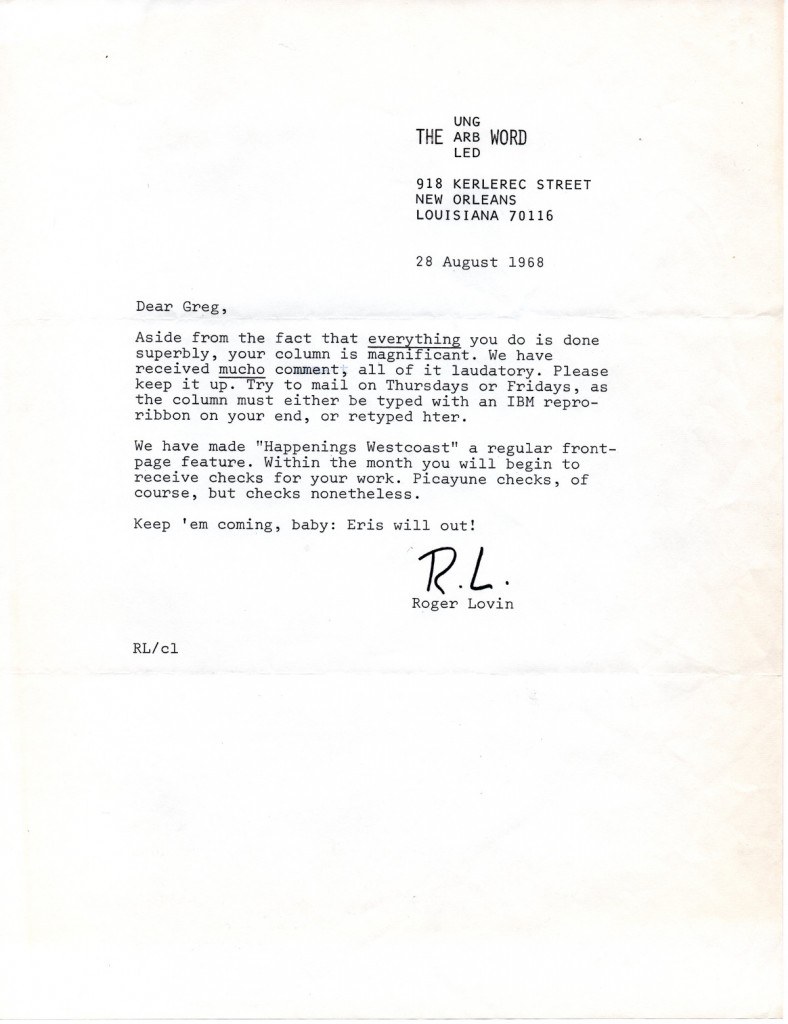
Happenings Westcoast became a regular feature in The Ungarbled Word and the title was soon changed to Etcetera Pacifica.
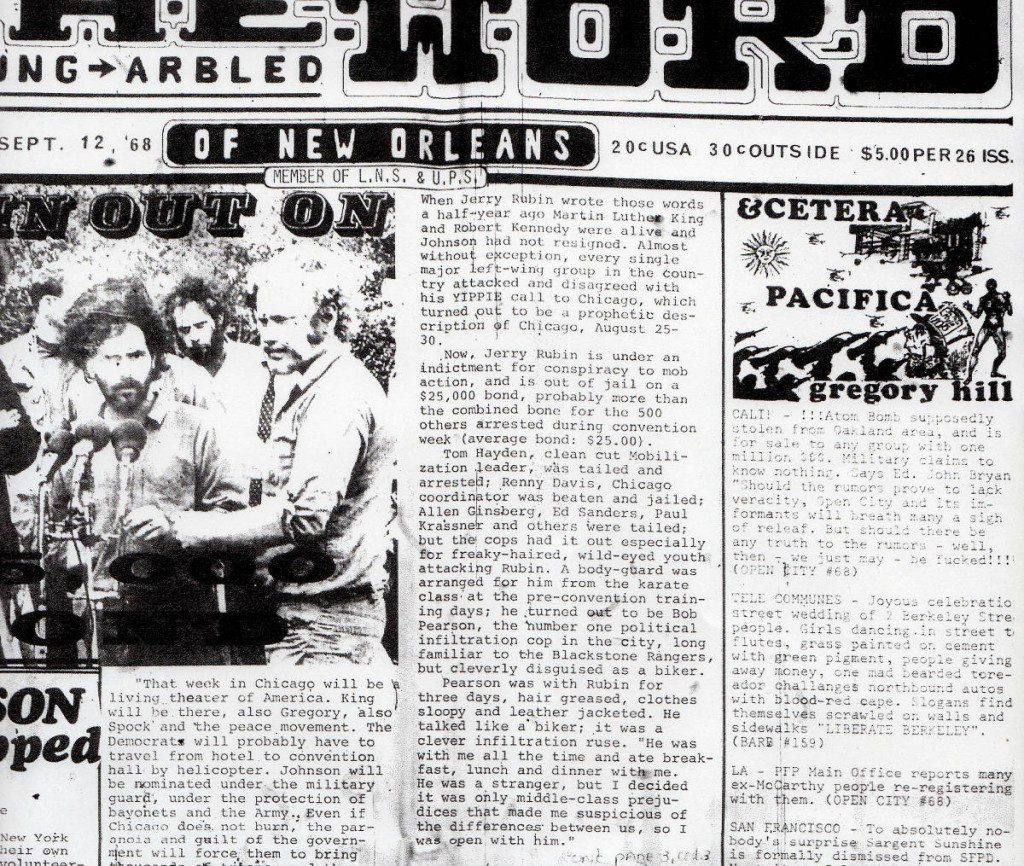
Hill produced the column for just a few months until December ’68 when he called it quits on account of his mounting frustration with anti-establishment militants.

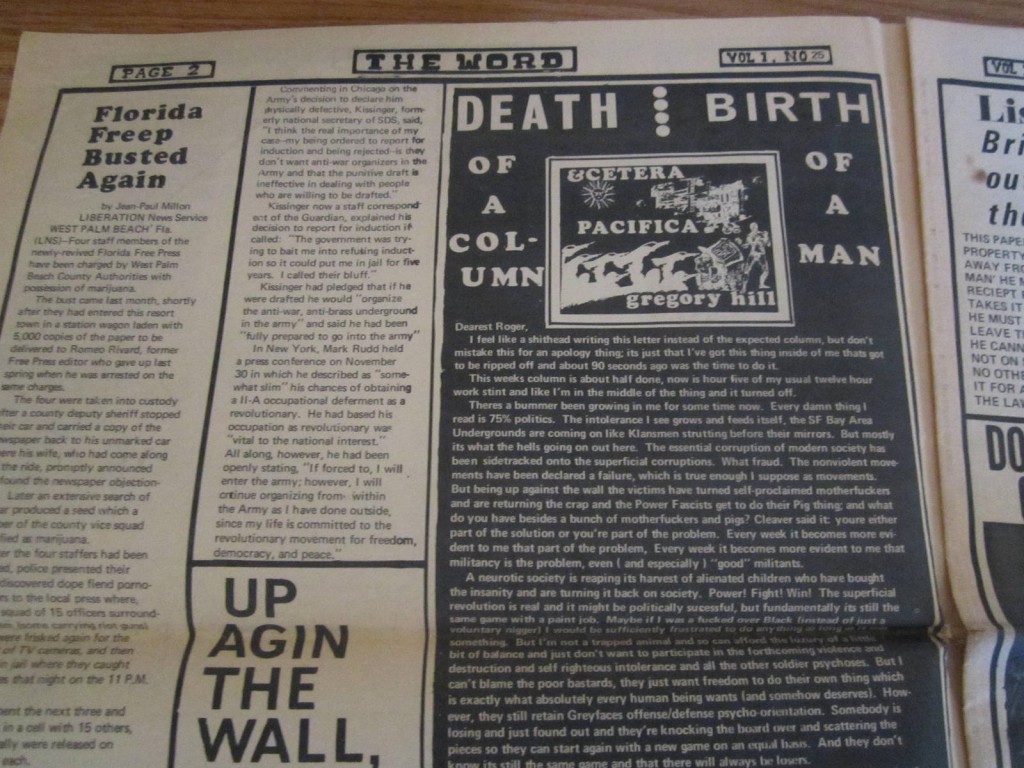
In the next installment of this series, we’ll examine how Roger Lovin got caught up in the Jim Garrison investigation madness.
Mucho thanks to Tim Cridland (aka Zamora the Torture King) for his assistance to this and future installments of our Roger Lovin series.

Born Roger Watlington in Knoxville, Tennessee on May 11, 1941, he later changed his name to Roger Lovin which would prove apropos in terms of the footloose and fancy free lifestyle he later adopted.
In the early 1960s, Lovin managed a French Quarter coffee house called The Gryphon, which doubled as a bohemian art gallery and hangout for French Quarter beatniks. In this regard, a curious news article appeared in the Oct 12, 1964 The Times-Picayune about a smoke bomb attack at The Gryphon that caused minor damage and one injury.
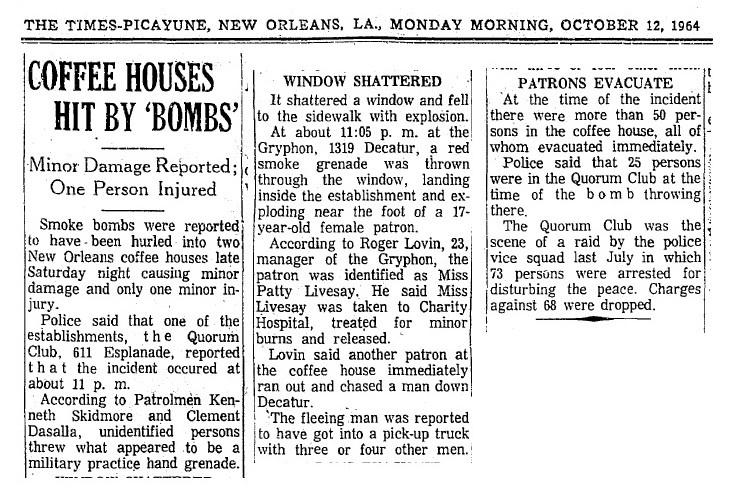
It’s unknown if the bombing was in any way directed at Lovin, although that wouldn’t come as a surprise as he was always a somewhat controversial character fond of ruffling the feathers of the squares. However, I suspect this incident may have had something to do with the bohemian clientele that frequented The Gryphon and a certain conservative element in New Orleans that was probably none too thrilled about it. As noted in the news article, a similar smoke bomb attack went down at the Quorum Coffee House (also known as The Quorum Club), another establishment with deep Discordian ties. A Wikipedia entry describes The Quorum as “a coffee house in New Orleans, known as a model for multicultural exchanges in the politically and racially charged atmosphere of the 1960s. It became a frequent target of segregationist harassment in New Orleans after it opened to persons from all racial backgrounds in 1963. In 1964, police raided The Quorum and arrested 73 people on charges such as ‘playing guitars out of tune.’”
Although The Quorum was a multicultural beatnik mecca, Kerry Thornley returned to New Orleans in the summer of 1964 and delivered a decidedly un-beatnik type lecture there on Ayn Rand and Objectivism—but that was typical Thornley: an iconoclast who reveled in tweaking people’s sensibilities on either side of the cultural or political spectrum. It’s also important to note that Kerry’s last meeting with the notorious Gary Kirstein (aka Brother-in-law who supposedly lured him into the JFK assassination) took place on the back patio of The Quorum (cast in creepy shadows) following Kerry’s lecture there that night.
Another Early Discordian, Barbara Reid (the main witness against Kerry in the Jim Garrison fiasco), became known as a “den mother” to a group of hippie kids that hung out at The Quorum, so the Discordian connections ran deep and weird. Apparently, there’s a film documentary about The Quorum called, appropriately enough (yes, you guessed it), The Quorum, which speaks to the influence this coffee house had on French Quarter culture. The website for The Quorum film describes how it was started in 1963 “by an idealistic group of individuals most of whom had met at the Ryder, an earlier, short-lived, racially integrated coffee house on Rampart Street in the New Orleans French Quarter. When the Ryder was shut down by city officials on the pretext of needing the space to construct a hotel, approximately twelve of the former Ryder patrons banded together to establish a similar sort of establishment with a similar purpose….”
As it so happens, the defunct Ryder coffee house (mentioned above) became of interest to Jim Garrison during his JFK assassination investigation as a supposed meeting place where Thornley had met with Lee Harvey Oswald and other suspected diabolical doings went down, which I previously covered in this post. But I digress…
The Quorum and Gryphon smoke bombings occurred during the same period Jim Garrison rolled out a campaign to “clean up” the French Quarter, and the specific targets of this campaign were strip clubs and establishments catering to the homosexual community. This is not to suggest that Garrison was in any way responsible for the smoke bomb caper, but what these events spoke to was the tension and unrest brewing across the cultural landscape, particularly in the French Quarter which had always been a fertile breeding ground for freaks and free spirits to flourish.
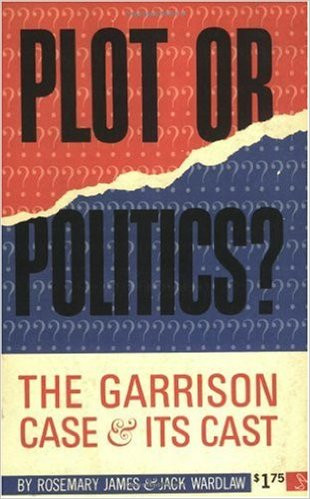
In regards to Garrison’s campaign against “vice,” pages 21 and 22 of Plot Or Politics? informs the reader that:
Almost as soon as he took office, Garrison took aim at the city’s sin strip—“The Street”, Bourbon Street. Former New Orleans newsman Bill Stuckey recalls:
“Shortly after he became district attorney in 1962, [Garrison] launched a crackdown on homosexuals in New Orleans, raiding ‘gay bars’ frequently, arresting ‘gay kids’ on the streets of the French Quarter. After one such arrest, the New Orleans States-Item sent me to the police station to see what the formal charges were. There, on paper, probably was one of the strangest charges in U.S. legal history: ‘Being a homosexual in an establishment with a liquor license.’ The drive died down after several weeks. One benefit of it may have been the creation of a body of homosexual informants for the district attorney’s office—informants possibly involved in his Kennedy plot investigation.”
It probably appears like I’m once again digressing, but I wanted to lay out the cultural landscape of the period—a culture in which Lovin was knee deep—and the conditions that precipitated the crackdown on the homosexual community, all of which might have attributed to the coffee house smoke bombings, and a cultural sea change which was only then just beginning to make waves…
When Greg Hill and Kerry Thornley moved away from the French Quarter in the mid-60s, they left the New Orleans branch of the Discordian Society in the capably chaotic hands of Mr. Lovin, whom Thornley described in the Illuminet Press intro of Principia Discordia as “a dashing, talented and handsome con artist who was too shallow to settle into any one thing. But for years and years after he read the Principia, under his Discordian name of Fang the Unwashed, he consistently and with unswerving devotion to the task excommunicated every new person any of the rest of us initiated into the Discordian Society.”
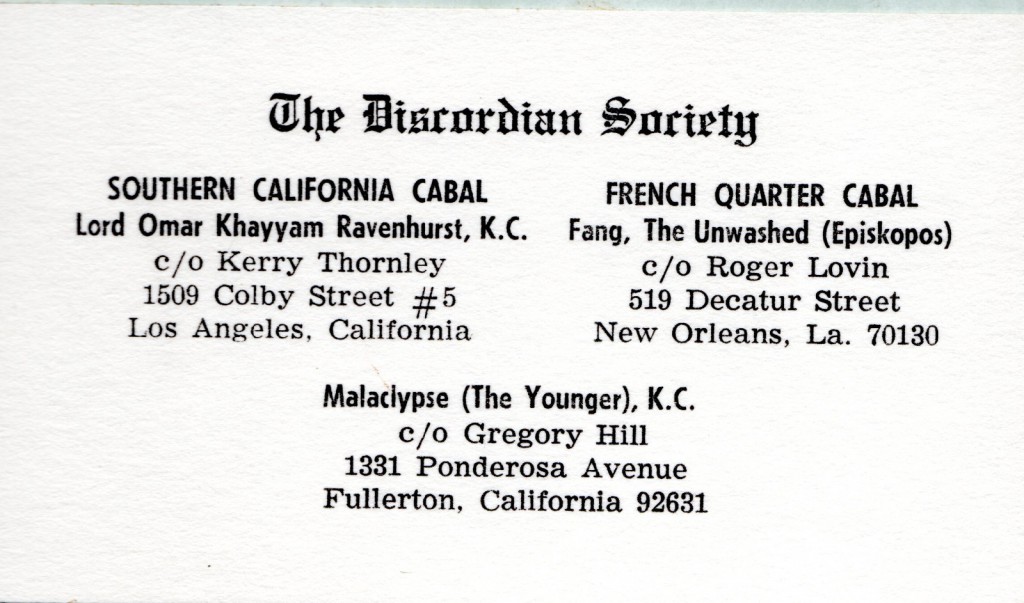
Kerry wasn’t just lightly tossing around the assertion that Lovin excommunicated new Discordian initiates, as revealed in this December 2, 1964 letter from Greg Hill (aka Malaclypse the Younger) to pilgrims Judy Gates and Bob Yeager.
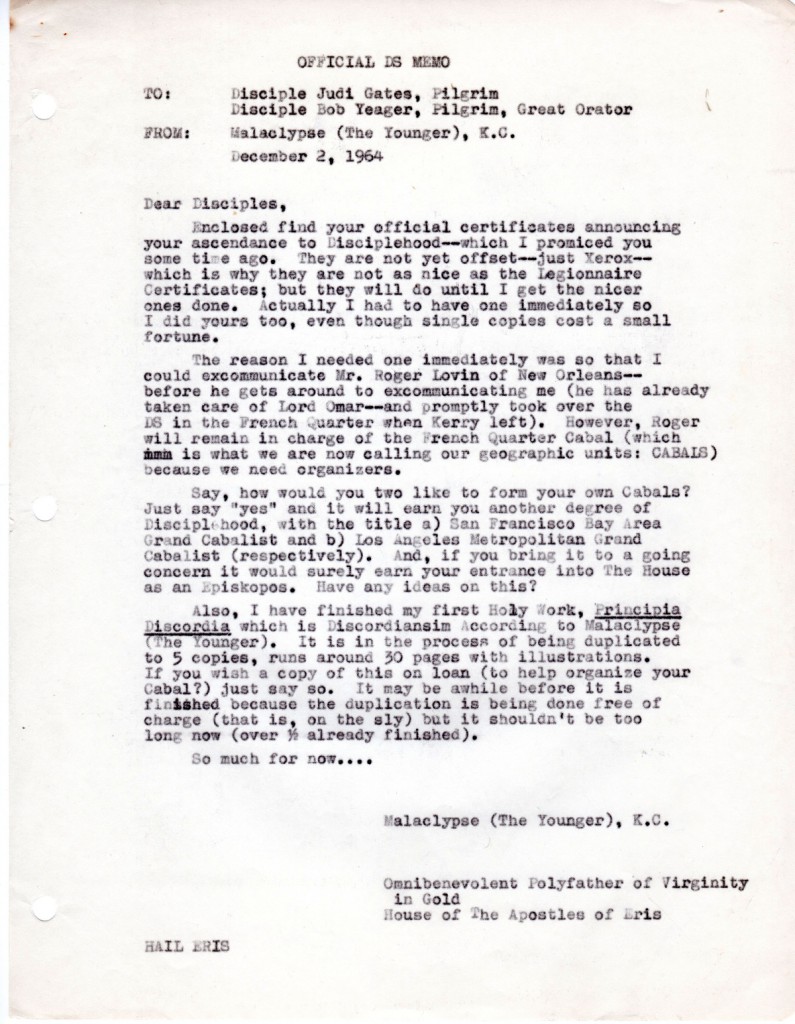
The Early Discordians become infamous for these types of humorous letters, and one of the funniest I’ve come across was composed by Lovin dated December 17, 1964, addressed to Greg Hill (who appears to have been staying with Bob Newport in Chicago at the time):
All Hail Discordia!!!!!?!!!!!!! To: MALACLYPSE (THE YOUNGER), K.C.: OMNIPOTENT POLYFATHER OF VIRGINITY IN GOLD AND HIGH PRIEST OF THE HERETIC FRINGE AND PROTESTANT PERSAUSION
FROM: FANG (THE UNWASHED), W.K.C.: LIBERATOR OF THE THIRD EYE, PROTECTOR of the WESTERN WORLD, EXALTED LAMA of the NEW ORLEANS CABAL, and L.L.L.L.L.L. (Lovin’s Licentiously Liberated Lightning Lechers)
Hail Eris,
Concerning thy recent epistle of Excommunication: Screw Thee. Thou wilt understand, of course, that it isn’t the humble Fang; but FANG, W.K.C.: L.T.E., P.W.W., E.L.N.O.C., and L.L.L.L.L.L. and wilt therefore realize that naught of a personal nature is meant… dig?
Wouldst do me the favor of communicating Lord Omar’s current whereabouts to me in the swiftest mode. This One is plagued with constant uncertainties and apprehensions due to an extreme dearth of information concerning That One. I fear me ever that the Foul Forces of Light and Reason have fallen upon him unaware and smotten (wow!) Him severely about the shoulders and intellect. Thou wouldst earn thyself everlasting gratitude and a mention in the evening maledictions by such an action. Also; if you don’t, I’ll kill you.
As to the progress of the New Orleans Cabal: The first Temple of Eris in New Orleans was formally defecated on Nov. 3, 1964, at 519 Decatur St. (which, oddly enough, is also my home address.) It occupied a converted broom closet. Admittedly, that is rather humble quarters for such a large and far-flung organization; but in the short space of one month we have more than doubled our area. This noble word was accomplished chiefly through the untiring efforts of our noble leader, FANG, W.K.C.: L.T.E., P.W.W., E.L.N.O.C., and L.L.L.L.L.L. and his noble assistant, Charles Noble. They single-handedly (one hand, three hooks) formed K.R.U.D. (Kollectors of Revenue Under Duress) and saw to the raising of funds. Our membership already includes two beatniks, one wasp, a hunchbrain, and a genuine, card carrying square who has 2.7 kids and a wife with a cloth coat. Therefore, be of good cheer. Today New Orleans, tomorrow the Catacombs – with some scattered showers in the evening.
As I am naturally curious about what sort of person would spend his time on such drivel as this, kindly send me some data about yourself. Send also a copy of HYMN. Barring the feasibility of a picture, send a piece of fingernail and some hair…..
In closing, let me say: MARY CHRISTMAS, SAVIOR MONEY!!!
(signed) FANG
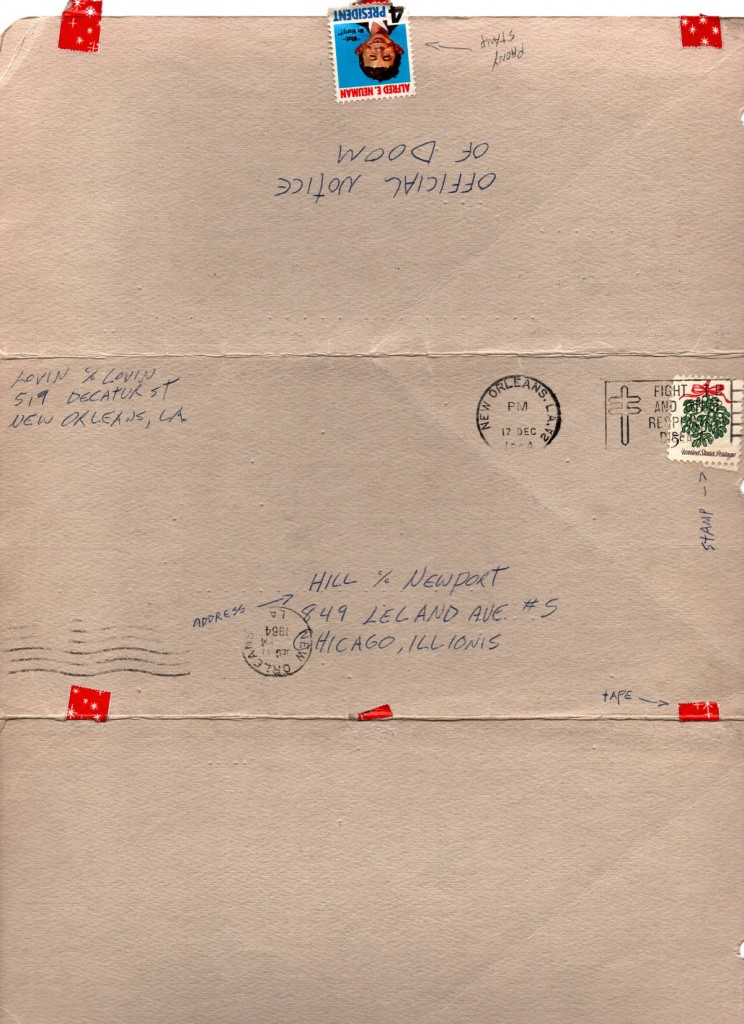
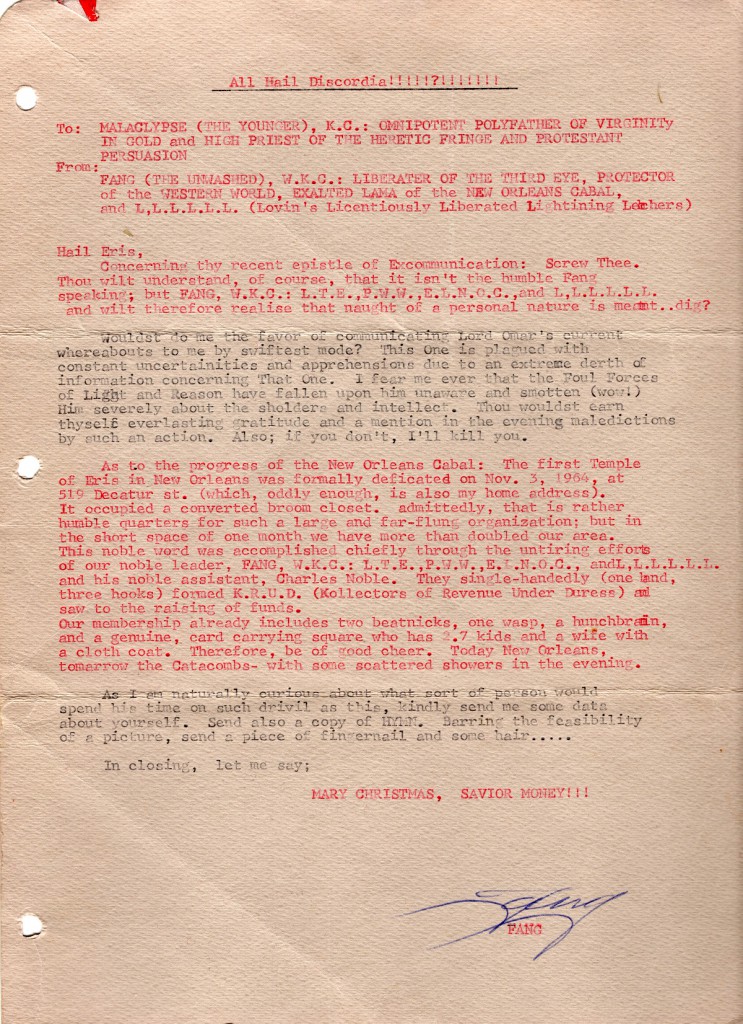
As the beatniks morphed into hippies, Lovin went right along for the ride. On December 9, 1966, he hosted a “psychedelic happening” billed as an “LSD trip without LSD” that certainly sounded Discordian in nature, as documented in the December 10, 1966 States Time Advocate news article below.
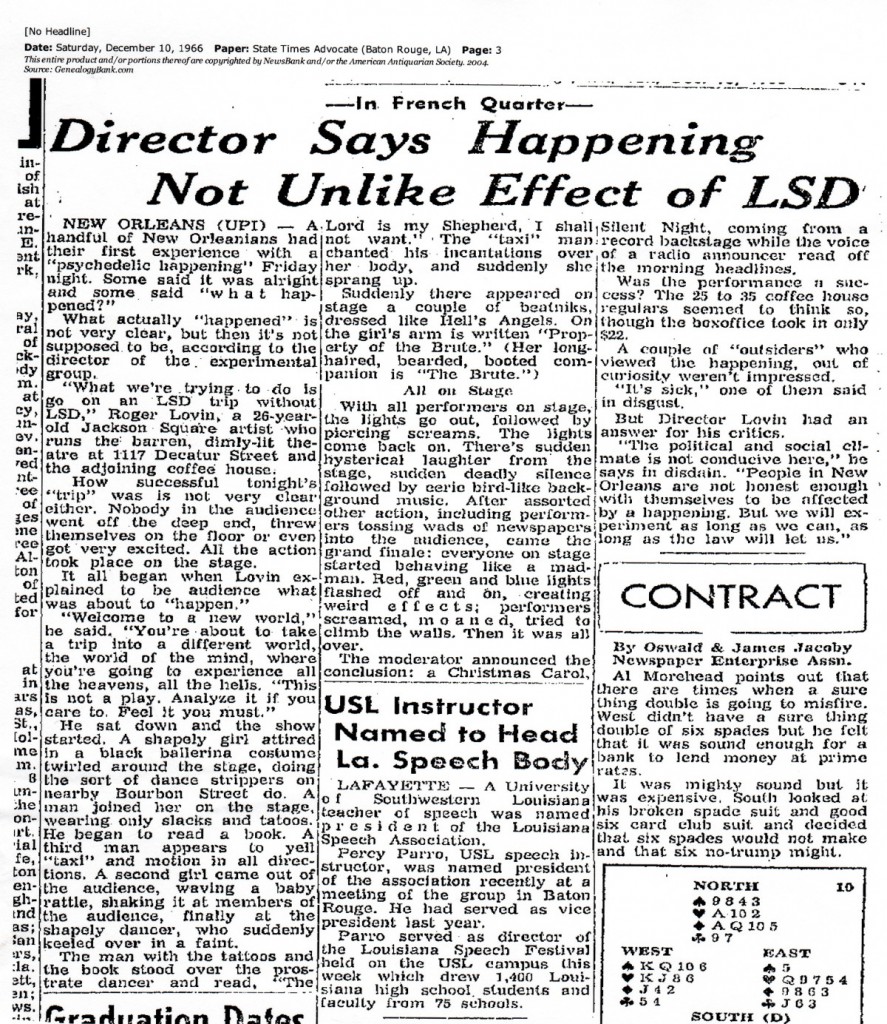
On October 16, 1968, Lovin appeared on TV program called Hotseat revealing “The Truth About Hippies.” It was around this time that he started the first underground newspaper in New Orleans, The Word (later to be known as The Ungarbled Word.) While all of this was going on, Lovin became a suspect of sorts in the Garrison investigation, all of which will be discussed in more detail than you can possibly imagine in future installment of this series!


This was today in Discordian history.

